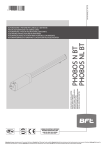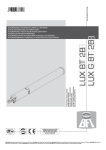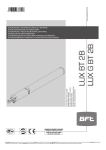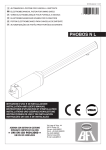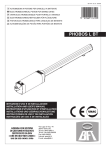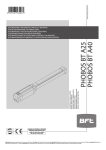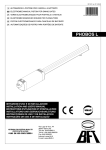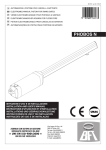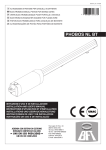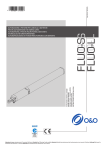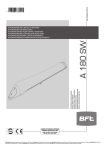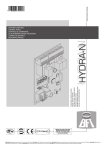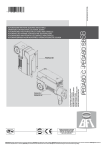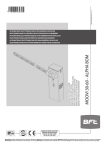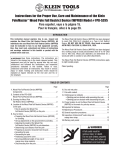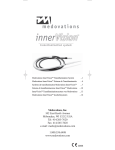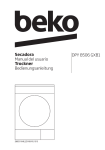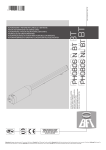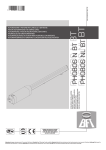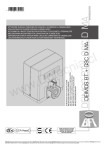Download PHOBOS N BT PHOBOS NL BT
Transcript
D811610 00100_01 28-01-10 PHOBOS PHOBOS N N BT BT PHOBOS PHOBOS NLNL BT BT ISTRUZIONI DI INSTALLAZIONE INSTALLATION MANUAL INSTRUCTIONS D’INSTALLATION Montageanleitung INSTRUCCIONES DE INSTALACION INSTALLATIEVOORSCHRIFTEN AUTOMAZIONI A PISTONE PER CANCELLI A BATTENTE PISTON AUTOMATIONS FOR SWING GATES AUTOMATIONS A PISTON POUR PORTAILS BATTANTS HYDRAULISCHER DREHTORANTRIEB AUTOMATIZACIONES A PISTON PARA PORTONES CON BATIENTE AUTOMATISERINGSSYSTEMEN MET ZUIGER VOOR VLEUGELPOORTEN Croatia: Distribution & Support www.torautomatic.hr Attenzione! Leggere attentamente le “Avvertenze” all’interno! Caution! Read “Warnings” inside carefully! Attention! Veuillez lire attentivement les Avertissements qui se trouvent à l’intérieur! Achtung! Bitte lesen Sie aufmerksam die „Hinweise“ im Inneren! ¡Atención¡ Leer atentamente las “Advertencias” en el interior! Let op! Lees de “Waarschuwingen”tigre aan de binnenkant zorgvuldig! D811610 00100_01 2 - PHOBOS N BT - PHOBOS NL BT D811610 00100_01 PREDISPOSIZIONE TUBI, TUBE ARRANGEMENT, PRÉDISPOSITION DES TUYAUX, VORBEREITUNG DER LEITUNGEN, DISPOSICIÓN DE TUBOS, VOORBEREIDING LEIDINGEN. 2 2 5 ,7 2x0 mm m 5m , 3x1 A 3x1 2 5 0,7 ITALIANO INSTALLAZIONE VELOCE-QUICK INSTALLATION-INSTALLATION RAPIDE SCHNELLINSTALLATION-INSTALACIÓN RÁPIDA - SNELLE INSTALLATIE mm 5x RG mm2 3x1 m 58 2x1 ,5 Q mm2 ,75 mm2 2x1 ,5 m 2 m 2 ,5 x1 R mm 3x1 ENGLISH 2x0 m2 ,5 m m2 3 2 m 5m ,7 x0 5 SCHEMA D’INSTALLAZIONE. INSTALLATION DIAGRAM. SCHÉMA D’INSTALLATION. INSTALLATIONSSCHEMA. ESQUEMA DE INSTALACIÓN. INSTALLATIESCHEMA. B x S F FRANÇAIS Z=b-x >45mm D = MAX 1800mm (Phobos N BT) D = MAX 5000mm (Phobos NL BT) b 2S hobos N BT) C=700 mm (P hobos NL BT) C=825 mm (P a P Phobos N BT S (mm) 125 kg (~ 1250 N) 250 Phobos NL BT kg 125 (~ 2500 N) kg b (mm) 20 30 40 50 3 b a 100 110 120 130 140 150 160 170 180 118 116 114 108 107 107 101 102 105 96 102 97 91 100 97 92 87 98 91 87 84 93 90 86 83 90 85 82 84 81 116 108 103 105 103 99 100 99 95 100 96 92 96 92 92 88 88 84 99 96 130 ÷ 160 130 ÷ 170 130 ÷ 180 130 ÷ 190 170 ÷ 260 180 ÷ 260 190 ÷ 260 200 ÷ 260 PHOBOS NL BT b a 100 110 120 130 140 150 160 170 180 190 200 210 220 230 130 140 150 160 170 180 190 200 210 220 230 240 250 260 104 103 103 102 101 101 100 99 99 99 98 98 98 97 107 107 106 105 105 104 103 103 103 102 101 100 100 100 111 109 108 108 108 107 106 106 104 103 102 102 102 104 115 114 112 111 111 109 108 108 107 107 105 105 106 110 116 115 114 112 111 111 110 109 108 106 106 105 105 120 118 117 116 115 114 113 112 111 109 108 108 123 121 120 118 117 116 115 114 112 110 110 125 124 122 121 120 118 117 115 112 110 127 126 123 122 120 119 117 111 109 128 126 125 124 122 118 115 110 128 126 125 123 118 113 108 126 123 120 116 112 110 122 118 114 111 107 116 114 111 106 PHOBOS N BT - PHOBOS NL BT - 3 NEDERLANDS 100 110 120 130 140 150 160 170 180 190 200 210 (~ 2500 N) b (mm) 130 ÷ 210 140 ÷ 210 150 ÷ 210 160 ÷ 210 PHOBOS N BT kg ESPAÑOL 2 100 ÷ 120 100 ÷ 130 100 ÷ 140 100 ÷ 150 250 (~ 1250 N) DEUTSCH 1 kg * * C * * Non in dotazione! Not provided! Pas fournis! Nicht mitgeliefert! No incluidos en el kit! Niet meegeleverd! CAVO DI ALIMENTAZIONE. POWER CABLE. CÂBLE D’ALIMENTATION. NETZKABEL. CABLE DE ALIMENTACIÓN. VOEDINGSKABEL. 2 3 1 2 3 1 D MOT MOT + FC 40 mm 5 mm 3 x 1,5 mm2 Ø=7.1÷9.6 FISSAGGIO MOTORE SU ANCORAGGIO A PILASTRO. ATTACHING MOTOR TO FASTENING ON PILLAR. FIXATION DU MOTEUR SUR L’ANCRAGGE SUR LE PILIER. BEFESTIGUNG DES MOTORS AUF VERANKERUNG AM PFEILER. FIJACIÓN MOTOR EN ANCLAJE AL PILAR. BEVESTIGING MOTOR OP VERANKERING MET PIJLER. E MASSIMA INCLINAZIONE. MAXIMUM TILT.INCLINAISON MAXIMUM. MAX. NEIGUNG. INCLINACIÓN MÁXIMA. MAXIMUM HELLING. F + 60 mm - 60 mm S1 R1 S1 2 Ø1 D1 M12 D1 R1 13 2,5 24 4 - PHOBOS N BT - PHOBOS NL BT D811610 00100_01 ANCORAGGI DEGLI ATTACCHI AL PILASTRO. FASTENING OF FITTINGS TO PILLAR. ANCRAGES DES RACCORDEMENTS SUR LE PILIER. VERANKERUNGEN DER ANSCCHLÜSSE AM PFEILER. ANCLAJES DE LAS FIJACIONES AL PILAR. VERANKERING VAN DE BEVESTIGINGEN AAN DE PIJLER. D811610 00100_01 CORRETTA INSTALLAZIONE. CORRECT INSTALLATION. INSTALLATION CORRECTE. RICHTIGE INSTALLATION. INSTALACIÓN CORRECTA. CORRECTE INSTALLATIE. G CHIUDI CLOSE FERME ÖFFNEN CERRAR SLUITEN CHIUDI CLOSE FERME ÖFFNEN CERRAR SLUITEN PHOBOS N BT PHOBOS NL BT 1 1 APRI OPEN OUVRE SCHLIESSEN ABRIR OPENEN APRI OPEN OUVRE SCHLIESSEN ABRIR OPENEN 100 mm 135 mm ANCORAGGI DEGLI ATTACCHI ALL’ANTA. FASTENING OF FITTINGS TO LEAF. ANCRAGES DES RACCORDEMENTS SUR LE VANTAIL. VERANKERUNGEN DER ANSCHLÜSSE AM FLÜGEL. ANCLAJES DE LAS FIJACIONES A LA HOJA. VERANKERING VAN DE BEVESTIGINGEN AAN DE VLEUGEL. * FISSAGGIO OPERATORE SULL’ANTA, OPERATOR ATTACHMENT ON DOOR, FIXATION DE L’ACTIONNEUR SUR LE VANTAIL, BEFESTIGUNG DES TRIEBS AM FLÜGEL, FIJACIÓN OPERADOR EN LA HOJA, BEVESTIGING BEDIENING OP DE VLEUGEL. I 2 J 3 FC2 (CLOSE) 1 CHIUDI CLOSE FERME ÖFFNEN CERRAR SLUITEN 2 Non in dotazione! Not provided! Pas fournis! Nicht mitgeliefert! No incluidos en el kit! Niet meegeleverd! REGOLAZIONE FINECORSA DI CHIUSURA, CLOSING LIMIT DEVICE ADJUSTMENT, RÉGLAGE DES FINS DE COURSE DE FERMETURE, VERANKERUNG DER ANSCHLÜSSE AM FLÜGEL, REGULACIÓN DEL FIN DE CARRERA DE CIERRE, AFSTELLING AANSLAG SLUITING. 1 H 3 ~5 mm A B A REGOLAZIONE FINECORSA DI APERTURA, OPENING LIMIT DEVICE ADJUSTMENT, RÉGLAGE DE LA FIN DE COURSE D’OUVERTURE , EINSTELLUNG DES ÖFFNUNGS-ENDSCHALTERS, REGULACIÓN DEL FIN DE CARRERA DE APERTURA, AFSTELLING EINDAANSLAG OPENING. ~5 APRI OPEN OUVRE SCHLIESSEN ABRIR OPENEN K mm FC1 (OPEN) PHOBOS N BT - PHOBOS NL BT - 5 102 825 Phobos N BT 943 Phobos NL BT Cu MAX 305 mm Phobos N BT Cu MAX 470 mm Phobos NL BT 72,5 mm Phobos N BT 108 mm Phobos NL BT 55 80 65 M N 807 Phobos N BT 925 Phobos NL BT 962 Phobos N BT 1080 Phobos NL BT b b a P O b 1 b 1 6 - PHOBOS N BT - PHOBOS NL BT Sinistra/Left/Gauche Links/Izquierda Esquerda Destra/Right/Droite Rechts/Derecha Direita 1 D811610 00100_01 L D811610 00100_01 ATTENZIONE Importanti istruzioni di sicurezza. Leggere e seguire attentamente l’opuscolo Avvertenze ed il Libretto istruzioni che accompagnano il prodotto poiché una installazione errata può causare danni a persone, animali o cose. Esse forniscono importanti indicazioni riguardanti la sicurezza, l’installazione, l’uso e la manutenzione. 1) SICUREZZA GENERALE ATTENZIONE! Una installazione errata o un uso improprio del prodotto, può creare danni a persone, animali o cose. • Smaltire i materiali di imballo (plastica, cartone, polistirolo, ecc.) secondo quanto previsto dalle norme vigenti. Non lasciare buste di nylon e polistirolo a portata dei bambini. • Conservare le istruzioni per allegarle al fascicolo tecnico e per consultazioni future. • Questo prodotto è stato progettato e costruito esclusivamente per l’utilizzo indicato in questa documentazione. Usi non indicati in questa documentazione potrebbero essere fonte di danni al prodotto e fonte di pericolo. • La Ditta declina qualsiasi responsabilità derivante dall’uso improprio o diverso da quello per cui è destinato ed indicato nella presente documentazione. • Non installare il prodotto in atmosfera esplosiva. • Gli elementi costruttivi della macchina e l’installazione devono essere in accordo con le seguenti Direttive Europee: 2004/108/CEE, 2006/95/ CEE, 2006/42/CEE, 99/05/CEE (e loro modifiche successive). Per tutti i Paesi extra CEE, oltre alle norme nazionali vigenti, per un buon livello di sicurezza è opportuno rispettare anche le norme sopracitate. • La Ditta declina qualsiasi responsabilità dall’inosservanza della Buona Tecnica nella costruzione delle chiusure (porte, cancelli, ecc.), nonché dalle deformazioni che potrebbero verificarsi durante l’uso. • Togliere l’alimentazione elettrica, prima di qualsiasi intervento sull’impianto. Scollegare anche eventuali batterie tampone se presenti. • Prevedere sulla rete di alimentazione dell’automazione, un interruttore o un magnetotermico onnipolare con distanza di apertura dei contatti uguale o superiore a 3,5 mm. • Verificare che a monte della rete di alimentazione, vi sia un interruttore differenziale con soglia da 0.03A. • Applicare tutti i dispositivi di sicurezza (fotocellule, coste sensibili, ecc.) necessari a proteggere l’area da pericoli di schiacciamento, convogliamento, cesoiamento, secondo ed in conformità alle direttive e norme tecniche applicabili. • Applicare almeno un dispositivo di segnalazione luminosa (lampeggiante) in posizione visibile, fissare alla struttura un cartello di Attenzione. • La Ditta declina ogni responsabilità ai fini della sicurezza e del buon funzionamento dell’automazione se vengono impiegati componenti di altri produttori. • Usare esclusivamente parti originali per qualsiasi manutenzione o riparazione. • Non eseguire alcuna modifica ai componenti dell’automazione se non espressamente autorizzata dalla Ditta. • Istruire l’utilizzatore dell’impianto per quanto riguarda i sistemi di comando applicati e l’esecuzione dell’apertura manuale in caso di emergenza. • Tutto quello che non è espressamente previsto in queste istruzioni, non è permesso. • L’installazione deve essere fatta utilizzando dispositivi di sicurezza e comandi conformi alla EN 12978. elettronica della centrale di comando. Il funzionamento a fine corsa è regolato elettronicamente nel quadro di comando. Per una buona sicurezza antischiacciamento, la forza di spinta deve essere di poco superiore a quella necessaria per muovere l’anta sia in chiusura che in apertura; la forza, misurata in punta all’anta, non deve comunque superare i limiti previsti dalle norme sopra indicate. COMANDO Il comando può essere di diverso tipo (manuale, con radiocomando, controllo accessi con badge magnetico, ecc.) secondo le necessità e le caratteristiche dell’installazione. Per i vari sistemi di comando, vedere le relative istruzioni. Gli utilizzatori dell’automazione devono essere istruiti al comando e all’uso. INCONVENIENTI E RIMEDI Funzionamento difettoso del motoriduttore • Verificare con apposito strumento la presenza di tensione ai capi del motoriduttore dopo il comando di apertura o chiusura. Se il motore vibra ma non gira, può essere: • Sbagliato il collegamento dei fili (rivedere schema di collegamento). • Se il movimento dell’anta, è contrario a quello che dovrebbe essere, invertire i collegamenti di marcia del motore nella centralina. Il primo comando dopo un’interruzione di rete deve essere di apertura ARRESTI ANTE. DEMOLIZIONE L’eliminazione dei materiali va fatta rispettando le norme vigenti. Nel caso di demolizione dell’automazione non esistono particolari pericoli o rischi derivanti dall’automazione stessa. È opportuno, in caso di recupero dei materiali, che vengano separati per tipologia (parti elettriche - rame - alluminio - plastica - ecc.). SMANTELLAMENTO Attenzione: Avvalersi esclusivamente di personale qualificato. Nel caso l’automazione venga smontata per essere poi rimontata in altro sito bisogna: • Togliere l’alimentazione e scollegare tutto l’impianto elettrico esterno. • Nel caso alcuni componenti non possano essere rimossi o risultino danneggiati, provvedere alla loro sostituzione. Il buon funzionamento dell’automazione è garantito solo se vengono rispettate i dati riportati in questo manuale. La Ditta non risponde dei danni causati dall’inosservanza delle norme di installazione e delle indicazioni riportate in questo manuale. Le descrizioni e le illustrazioni del presente manuale non sono impegnative. Lasciando inalterate le caratteristiche essenziali del prodotto, la Ditta si riserva di apportare in qualunque momento le modifiche che essa ritiene convenienti per migliorare tecnicamente, costruttivamente e commercialmente il prodotto, senza impegnarsi ad aggiornare la presente pubblicazione. VERIFICA DELL’AUTOMAZIONE Prima di rendere definitivamente operativa l’automazione, controllare scrupolosamente quanto segue: • Verificare che tutti i componenti siano fissati saldamente. • Controllare il corretto funzionamento di tutti i dispositivi di sicurezza (fotocellule, costa pneumatica, ecc). • Verificare il comando della manovra di emergenza. • Verificare l’operazione di apertura e chiusura con i dispositivi di comando applicati. • Verificare la logica elettronica di funzionamento normale (o personalizzata) nella centralina di comando. REGOLAZIONE DELLA FORZA DI SPINTA ATTENZIONE: Verificare che il valore della forza d’impatto misurato nei punti previsti dalla norma EN 12445, sia inferiore a quanto indicato nella norma EN 12453. La forza di spinta si regola con estrema precisione mediante regolazione PHOBOS N BT - PHOBOS NL BT - 7 ITALIANO AVVERTENZE GENERALI 2) GENERALITÀ Attuatore elettromeccanico progettato per automatizzare cancelli di tipo residenziale. Il motoriduttore mantiene il blocco in chiusura ed apertura senza necessità di elettroserratura per ante di lunghezza massima di 3 m. L’attuatore è provvisto di limitatore di coppia elettronico. Deve essere comandato da un quadro comandi elettronico dotato di regolazione di coppia. Il funzionamento a finecorsa è regolato da due finecorsa magnetici. L’attuatore è provvisto di un sistema di rilevamento ostacoli secondo le normative EN12453 e EN 12445. Sono disponibili i seguenti accessori opzionali: - Kit batteria tampone mod. BT BAT Consente il funzionamento dell’automazione anche se manca per un breve periodo l’alimentazione di rete. 3) DATI TECNICI PHOBOS N - NL BT 24V 40 W 1,5 A 2000 N (~200 kg) 15 mm/s circa Limitatore di coppia integrato su quadro di comando Finecorsa Magnetici incorporati e regolabili Manovra manuale Chiave CLS di sblocco Condizione ambientali - 20°C a +50°C Tipo di utilizzo semi-intensivo Massima lunghezza anta 1,8 m Phobos N BT senza elettroserratura 3 m Phobos NL BT Massima lunghezza anta 5 m Phobos NL BT con elettroserratura Massimo peso anta 2500 N (~250 kg) Grado di protezione IP X4 50N (~5kg) PHOBOS N BT Peso attuatore 77N (~7,7kg) PHOBOS NL BT Dimensioni Vedere Fig. L Lubrificazione grasso permanente Alimentazione Potenza max assorbita Corrente assorbita Forza di spinta e trazione Velocità Stelo Reazione all’urto 4) PREDISPOSIZIONE TUBI Fig. A Predisporre l’impianto elettrico facendo riferimento alle norme vigenti per gli impianti elettrici CEI 64-8, IEC364, armonizzazione HD384 ed altre norme nazionali. 5) SCHEMA D’INSTALLAZIONE Fig. B P staffa posteriore di fissaggio al pilastro F forcella anteriore di fissaggio dell’anta a-b quote per determinare il punto di fissaggio della staffa “P” C valore dell’interasse di fissaggio D lunghezza del cancello X distanza dall’asse del cancello allo spigolo del pilastro S metà spessore anta Z valore sempre superiore a 45 mm (b - X) kg peso max dell’anta α° angolo d’apertura dell’anta 6) QUOTE D’INSTALLAZIONE ANCORAGGI A PILASTRO Fig. B Rif. 2 -3 6.1) Come interpretare la tabella delle misure di installazione Dalla tabella è possibile scegliere valori di “a” e “b” in funzione dei gradi α° di apertura che si desiderano ottenere. Sono evidenziati i valori di “a” e di “b” ottimali per un’apertura di 92° a velocità costante. Se si utilizzano valori di “a” e “b” troppo diversi tra loro, il movimento dell’anta non è costante e la forza di trazione o spinta varia durante il movimento. Per rispettare la velocità di apertura e garantire un buon funzionamento dell’operatore è opportuno che i valori “a” e “b” siano poco diversi tra loro. La tabella è stata ricavata per un cancello medio di spessore 40 mm (PHOBOS NL BT), 20 mm (PHOBOS N BT). Verificare sempre che non ci siano collisioni tra cancello ed attuatore. 8 - PHOBOS N BT - PHOBOS NL BT 7) ANCORAGGI DEGLI ATTACCHI AL PILASTRO Fig. C 8) CAVO DI ALIMENTAZIONE Fig. D Il cavo di alimentazione della scheda dev’essere di tipo H 05 RN-F o equivalenti. Il cavo equivalente deve garantire: - utilizzo esterno permanente - temperatura max sulla superficie del cavo +50° C - temperatura minima -25° C 9) FISSAGGIO MOTORE SU ANCORAGGIO A PILASTRO Fig. E 10) MASSIMA INCLINAZIONE Fig. F 11) CORRETTA INSTALLAZIONE Fig. G Una corretta installazione prevede di mantenere un margine di corsa dello stelo di circa 5-10 mm; ciò evita possibili anomalie di funzionamento. 12) ANCORAGGI DEGLI ATTACCHI ALL’ANTA Fig. H IMPORTANTE: il montaggio della staffa anteriore deve avvenire con il collarino boccola sporgente VERSO L’ALTO (Fig. G Rif. 1). 13) FISSAGGIO OPERATORE SULL’ANTA Fig. I 14) REGOLAZIONE FINECORSA CHIUSURA Fig. J ATTENZONE! Per evitare la rottura del cavo del finecorsa, fissare la vite A tenendo teso il filo B (come rappresentato in Fig. J Rif. 3). 15) REGOLAZIONE FINECORSA APERTURA Fig. K 16) DIMENSIONI Fig. L 17) ACCORGIMENTI PER INSTALLAZIONI PARTICOLARI Fig. M, N, O. Quando l’anta è completamente aperta, realizzare una nicchia per raccogliere l’operatore. In Fig. M sono riportate le misure di nicchia minime per i vari modelli PHOBOS N BT - PHOBOS N L BT. Se la quota “b” risulta superiore ai valori riportati nelle tabelle di installazione: - ricavare una nicchia nel pilastro Fig. N. - avvicinare l’anta al filo pilastro Fig. O. 18) BATTUTE D’ARRESTO DELLE ANTE AL SUOLO Per il corretto funzionamento dell’attuatore è consigliato utilizzare delle battute di arresto “Fig. P Rif. 1” sia in apertura che in chiusura come indicato in Fig. P. Le battute d’arresto delle ante, devono evitare che lo stelo dell’attuatore vada a finecorsa. 19) APERTURA MANUALE (Vedi MANUALE D’USO -FIG.Y-). 20) ELETTROSERRATURA ATTENZIONE: nel caso di ante di lunghezza superiore a 3m, risulta indispensabile l’installazione di un’elettroserratura a scatto. Per il collegamento dell’elettroserratura è necessaria la scheda opzionale (consultare l’apposita istruzione). D811610 00100_01 MANUALE PER L’INSTALLAZIONE D811610 00100_01 GENERAL WARNINGS WARNING! Important safety instructions. Carefully read and comply with the Warnings booklet and Instruction booklet that come with the product as incorrect installation can cause injury to people and animals and damage to property. They contain important information regarding safety, installation, use and maintenance. CONTROL There are various options when it comes to the control system (manual, remote control, access control with magnetic badge, etc.) depending on the installation’s needs and characteristics. See the relevant instructions for the various control system options. People due to use the automated device must be instructed how to control and use it. TROUBLESHOOTING Gearbox malfunctioning • Use an appropriate instrument to check for voltage across the gearbox motor terminals after giving the opening or closing command. If the motor vibrates but does not rotate, the problem may be: • Incorrect wiring (see wiring diagram) • If the leaf moves in the wrong direction, swap over the motor’s start connections in the control unit. The first command following a mains power outage should be open STOP LEAVES. SCRAPPING Materials must be disposed of in conformity with the current regulations. In case of scrapping, the automation devices do not entail any particular risks or danger. In case of recovered materials, these should be sorted out by type (electrical components, copper, aluminium, plastic etc.). DISMANTLING WARNING: before opening the door, the spring must be unloaded (vertical boom). When the automation system is disassembled to be reassembled on another site, proceed as follows: - Disconnect the power supply and the entire electrical installation. - Remove the actuator from its fixing base. - Disassemble all the installation components. - In the case where some of the components cannot be removed or are damaged, they must be replaced. Correct controller operation is only ensured when the data contained in the present manual are observed. The Company is not to be held responsible for any damage resulting from failure to observe the installation standards and the instructions contained in the present manual. The descriptions and illustrations contained in the present manual are not binding. The Company reserves the right to make any alterations deemed appropriate for the technical, manufacturing and commercial improvement of the product, while leaving the essential product features unchanged, at any time and without undertaking to update the present publication. CHECKING INSTALLATION Before the automated device is finally put into operation, perform the following checks meticulously: • Make sure all components are fastened securely. • Check that all safety devices (photocells, pneumatic safety edge, etc.) are working properly. • Check the emergency operation control device. • Check opening and closing operations with the control devices applied. • Check the electronic logic for normal (or personalized) operation in the control panel. ADJUSTING OPERATING FORCE WARNING: Check that the force of impact measured at the points provided for by standard EN 12445 is lower than the value laid PHOBOS N BT - PHOBOS NL BT - 9 ENGLISH 1) GENERAL SAFETY WARNING! An incorrect installation or improper use of the product can cause damage to persons, animals or things. • Scrap packing materials (plastic, cardboard, polystyrene etc) according to the provisions set out by current standards. Keep nylon or polystyrene bags out of children’s reach. • Keep the instructions together with the technical brochure for future reference. • This product was exclusively designed and manufactured for the use specified in the present documentation. Any other use not specified in this documentation could damage the product and be dangerous. • The Company declines all responsibility for any consequences resulting from improper use of the product, or use which is different from that expected and specified in the present documentation. • Do not install the product in explosive atmosphere. • The units making up the machine and its installation must meet the requirements of the following European Directives: 2004/108/EEC, 2006/95/ EEC, 2006/42/EEC, 99/05/EEC (and later amendments). For all countries outside the EEC, it is advisable to comply with the above-mentioned standards, in addition to any national standards in force, to achieve a good level of safety. • The Company declines all responsibility for any consequences resulting from failure to observe Good Technical Practice when constructing closing structures (door, gates etc.), as well as from any deformation which might occur during use. • The installation must comply with the provisions set out by the following European Directives: 2004/108/EEC, 2006/95/EEC, 2006/42/EEC, 99/05/ EEC and subsequent amendments. • Disconnect the electrical power supply before carrying out any work on the installation. Also disconnect any buffer batteries, if fitted. • Fit an omnipolar or magnetothermal switch on the mains power supply, having a contact opening distance equal to or greater than 3,5 mm. • Check that a differential switch with a 0.03A threshold is fitted just before the power supply mains. • Fit all the safety devices (photocells, electric edges etc.) which are needed to protect the area from any danger caused by squashing, conveying and shearing, according to and in compliance with the applicable directives and technical standards. • Position at least one luminous signal indication device (blinker) where it can be easily seen, and fix a Warning sign to the structure. • The Company declines all responsibility with respect to the automation safety and correct operation when other manufacturer’s components are used. • Only use original parts for any maintenance or repair operation. • Do not modify the automation components, unless explicitly authorised by the Company. • Instruct the product user about the control systems provided and the manual opening operation in case of emergency. • Anything which is not expressly provided for in the present instructions, is not allowed. • Installation must be carried out using the safety devices and controls prescribed by the EN 12978 Standard. down by standard EN 12453. Operating force is adjusted with extreme precision by means of the control unit’s electronic control. Operation at the end of travel is adjusted electronically in the control panel. To provide good anti-crush safety, the operating force must be slightly greater than that required to move the leaf both to close and to open it. Whatever the case, the force, which is measured at the top outer edge of the leaf, must not exceed the limits laid down by the above-mentioned standards. 2) GENERAL INFORMATION Electromechanical operator designed to automate residential-type gates. The gearmotor keeps the gate locked on closing and on opening, without needing an electric lock for leaves up to 3 m long. For leaves ranging between 3m and 5m long, the electric lock becomes indispensable. The operator is provided with an electronic torque limiter. It must be controlled by an electronic control panel provided with torque setting. The end-of-stroke operation is controlled by two magnetic limit devices. The operator is provided with an obstacle detection system complying with EN12453 and EN 12445 standards. 8) POWER CABLE Fig. D The board power supply cable must be of the H 05 RN-F type or equivalent. The equivalent cable must guarantee: - permanent outside use - maximum temperature on the cable surface of +50° C - minimum temperature of -25° C The following optional accessories are available on request: - Buffer battery kit mod. BT BAT Allows operation of the automation even when there is no mains power supply for a short period of time. 11) CORRECT INSTALLATION Fig. G Correct installation entails maintaining a rod stroke margin of approx. 5-10 mm to avoid possible trouble with operation. 3) TECHNICAL SPECIFICATIONS PHOBOS N - NL BT Power supply 24V Max. Absorbed power 40 W Absorbed current 1,5 A Push and pull force 2000 N (~200 kg) Stem speed 15 mm/s approx. Impact reaction Torque limiter aboard control board Limit devices Magnetic, incorporated and adjustable Manual manoeuvre CLS release key Environmental conditions - 20°C a +50°C Type of use semi-intensive Maximum leaf length without 1,8 m Phobos N BT electric lock 3 m Phobos NL BT Maximum leaf length with elec5 m Phobos NL BT tric lock Max. leaf weight 2500 N (~250 kg) Protection level IP X4 50N (~5kg) PHOBOS N BT Controller weight 77N (~7,7kg) PHOBOS NL BT Dimensions See Fig. L Lubrication permanent grease 4) TUBE ARRANGEMENT Fig. A Install the electrical system referring to the standards in force for electrical systems CEI 64-8, IEC 364, harmonization document HD 384 and other national standards. 5) INSTALLATION DIAGRAM Fig. B P rear bracket fastening to pillar F front fork fastening leaf a-b distances for determining bracket “P” fastening point C value of fastening centre-to-centre distance D gate length X distance from gate axis to corner of pillar S half door thickness Z value always greater than 45 mm (b - X) kg max. weight of leaf α° leaf opening angle 6) PILLAR FASTENINGS INSTALLATION DISTANCES Fig. B Rif. 2-3 6.1) How to read the installation distance tables Select“a”and“b”according to the angle in degrees α° that the gate has to open.The optimum “a” and “b” values for 92° opening at constant speed are highlighted. If there is too large a difference between “a” and “b”, the leaf will not travel smoothly and the pushing or pulling force will fluctuate during its stroke. To respect the opening speed and ensure the controller operates correctly, it is best to keep the difference between “a” and “b” as low as possible. The table has been worked out for a 40 mm (PHOBOS NL BT), 20 mm (PHOBOS N BT) thick medium-size gate. Always check that there is no possible collision between the gate and the operator. 7) FASTENING OF FITTINGS TO PILLAR Fig. C 10 - PHOBOS N BT - PHOBOS NL BT 9) ATTACHING MOTOR TO FASTENING ON PILLAR Fig. E 10) MAXIMUM TILT Fig. F 12) FASTENING OF FITTINGS TO LEAF Fig. H IMPORTANT: the front bracket must be fitted with the bush collar protruding UPWARDS (Fig. G Ref. 1). 13) OPERATOR ATTACHMENT ON DOOR Fig. I 14) Closing limit device adjustment Fig. J ATTENTION! To avoid braking the limit switch cable, tighten screw A keeping the wire B well tightened (as shown in Fig. J Rif. 3). 15) Opening limit device adjustment (Fig. K) 16) DIMENSIONS Fig. L 17) TIPS FOR SPECIAL INSTALLATIONS Fig. M, N, O. With the leaf fully open, create a recess to accommodate the operator. Fig. M gives the minimum dimensions of the recess for the various PHOBOS N BT - PHOBOS N L BT models. If distance “b” is greater than the values given in the installation tables: - create a recess in the pillar Fig. N - move the leaf so that it is flush with the pillar Fig. O. 18) LEAF STOPS AT GROUND LEVEL For the actuator to work properly, it is advisable to use stops “Fig. P Rif. 1” to stop the leaves both when they are open and closed, as illustrated in Fig. P. The leaf stops must prevent the actuator rod from reaching the end of its travel. 19) MANUAL OPENING (See USER GUIDE -FIG.Y-). 20) ELECTRIC LOCK WARNING: In the case of leaves longer than 3m, it is indispensable to install a solenoid latch. For electric lock connection, the optional board is required (refer to the appropriate instruction). D811610 00100_01 INSTALLATION MANUAL D811610 00100_01 AVERTISSEMENTS GÉNÉRAUX ATTENTION! Consignes de sécurité importantes. Lire et suivre attentivement la brochure Avertissement et le livret d’instructions fournis avec le produit sachant qu’une installation incorrecte peut provoquer des dommages aux personnes, aux animaux ou aux choses. Elles fournissent des indications importantes concernant la sécurité, l’installation, l’utilisation et l’entretien. RÉGLAGES DE LA FORCE DE POUSSÉE ATTENTION : Vérifier si la valeur de la force d’impact mesurée dans les points prévus par la norme EN12445 est inférieure à celle indiquée dans la norme EN 12453. La force de poussée se règle de façon très précise avec le dispositif de réglage électronique de la centrale de commande. Le fonctionnement en fin de course est réglé électroniquement dans le tableau de commande. Pour garantir une bonne sécurité anti-écrasement, la force de poussée doit être légèrement supérieure à celle nécessaire pour déplacer le vantail, à la fermeture et à l’ouverture; la force mesurée à l’extrémité du vantail ne doit jamais dépasser les limites prévues par les normes citées plus haut. COMMANDE La commande peut être de différents types (manuelle, avec radiocommande, contrôles des accès avec un badge magnétique, etc.) en fonction des nécessités et des caractéristiques d’installation. Pour les différents systèmes de commande, voir les instructions correspondantes. Les utilisateurs de l’automatisation doivent connaître toutes les informations sur la commande et son utilisation. INCONVÉNIENTS ET REMÈDES Mauvais fonctionnement du motoréducteur • Vérifier avec l’instrument prévu à cet effet la présence de tension aux extrémités du motoréducteur après la commande d’ouverture ou de fermeture. Si le moteur vibre mais ne tourne pas, il se peut que: • Le branchement des fils soit erroné (revoir le schéma de branchement). • Si le mouvement du vantail est opposé à celui prévu, invertir les branchements de marche du moteur dans la centrale. La première commande après une coupure de courant doit être ouverture ARRÊT VANTAIL. DEMOLITION L’élimination des matériaux doit être faite en respectant les normes en vigueur. En cas de démolition de l’automatisme, il n’existe aucun danger ou risque particulier dérivant de l’automatisme. En cas de récupération de matériaux, il est opportun de les séparer selon le genre (parties électriques - cuivre - aluminium - plastique - etc.). DEMANTELEMENT ATTENTION: avant d’ouvrir la porte, le ressort doit être déchargé (lisse verticale). Si l’automatisme est démonté pour être ensuite remonté ailleurs, il faudra: - Couper l’alimentation et débrancher toute l’installation électrique. Enlever le vérin de la base de fixation. - Démonter tous les composants de l’installation. - Si des composants ne peuvent pas être démontés ou sont endommagés, il faudra les remplacer. Le bon fonctionnement de l’actionneur n’est assuré que si les données fournies dans ce manuel sont respectées. Le constructeur ne répond pas pour les dommages provoqués par le non respect des normes d’installation et des indications fournies dans ce manuel. Les descriptions et les figures de ce manuel n’engagent pas le constructeur. En laissant inaltérées les caractéristiques essentielles du produit, la Société se réserve le droit d’apporter à n’importe quel moment les modifications qu’elle juge opportunes pour améliorer le produit du point de vue technique, commercial et de construction, sans s’engager à mettre à jour cette publication. CONTROLE DE L’INSTALLATION Vérifier scrupuleusement ce qui suit avant de rendre l’automatisation définitivement opérationnelle : • Vérifier si tous les composants sont solidement fixés. • Contrôler le fonctionnement correct de tous les dispositifs de sécurité (photocellules, linteaux pneumatiques, etc.) • Vérifier la commande de la manœuvre d’urgence. • Vérifier l’opération d’ouverture et de fermeture avec les dispositifs de commande appliqués. • Vérifier la logique électronique de fonctionnement normal (ou personPHOBOS N BT - PHOBOS NL BT - 11 FRANÇAIS 1) SECURITE GENERALE ATTENTION! Une installation erronée ou une utilisation impropre du produit peuvent provoquer des lésions aux personnes et aux animaux ou des dommages aux choses. • Eliminer les matériaux d’emballage (plastique, carton, polystyrène etc.) selon les prescriptions des normes en vigueur. Ne pas laisser des enveloppes en nylon et polystyrène à la portée des enfants. • Conserver les instructions et les annexer à la fiche technique pour les consulter à tout moment. • Ce produit a été conçu et réalisé exclusivement pour l’utilisation indiquée dans cette documentation. Des utilisations non indiquées dans cette documentation pourraient provoquer des dommages au produit et repré-senter une source de danger pour l’utilisateur. • La Société décline toute responsabilité dérivée d’une utilisation impropre ou différente de celle à laquelle le produit a été destiné et qui est indiquée dans cette documentation. • Ne pas installer le produit dans une atmosphère explosive. • Les éléments qui composent l’appareil doivent être conformes aux Directives Européennes suivantes : 2004/108/CE, 2006/95/CE, 2006/42/ CE, 99/05/CE (et leurs modifications successives). Dans tous les pays n’appartenant pas à la CEE nous vous conseillons de respecter aussi les normes ci-dessus, outre les règlements nationaux en vigueur, afin de garantir un bon niveau de sécurité. • La Société décline toute responsabilité en cas de non respect des règles de bonne technique dans la construction des fermetures (portes, portails etc.), ainsi qu’en cas de déformations pouvant se produire pendant l’utilisation. • L’installation doit être conforme aux prescriptions des Directives Européennes: 2004/108/CEE, 2006/95/CEE, 2006/42 CEE, 99/05/CEE et modifications successives. • Couper l’alimentation électrique avant d’effectuer n’importe quelle intervention sur l’installation. Débrancher aussi les éventuelles batteries de secours. • Prévoir sur la ligne d’alimentation de la motorisation un interrupteur ou un magnétothermique omnipolaire avec distance d’ouverture des contacts égale ou supérieure à 3,5 mm. • Vérifier qu’en amont de la ligne d’alimentation il y a un interrupteur différentiel avec seuil de 0,03A. • Appliquer tous les dispositifs de sécurité (cellules photoélectriques, barres palpeuses etc.) nécessaires à protéger la zone des dangers d’écrasement, d’entraînement, de cisaillement, selon et conformément aux directives et aux normes techniques applicables. • Appliquer au moins un dispositif de signalisation lumineuse (feu clignotant) en position visible, fixer à la structure un panneau de Attention. • La Société décline toute responsabilité en matière de sécurité et de bon fonctionnement de la motorisation si des composants d’autres producteurs sont utilisés. • Utiliser exclusivement des pièces originales pour n’importe quel entretien ou réparation. • Ne pas effectuer des modifications aux composants de la motorisation si non expressément autorisées par la Société. • Informer l’utilisateur de l’installation sur les systèmes de commande appliqués et sur l’exécution de l’ouverture manuelle en cas d’urgence. • Tout ce qui n’est pas expressément prévu dans ces instructions, est interdit. • L’installation doit être faite en utilisant des dispositifs de sécurité et des commandes conformes à la norme EN 12978. nalisé) dans la centrale de commande. 2) GÉNÉRALITÉS Actionneur électromécanique conçu pour automatiser les portails de type résidentiel. Le motoréducteur maintient le blocage en fermeture et ouverture sans nécessité de serrure électrique pour des vantaux ayant une longueur maxi de 3m. Pour des vantaux ayant une longueur comprise entre 3m et 5m la serrure électrique est indispensable. L’opérateur est doté d’un limiteur de couple électronique. Il doit être commandé par une centrale de commande électronique dotée de réglage du couple. Le fonctionnement avec fin de course est réalisé par deux fins de course magnétiques. L’opérateur est doté d’un système de détection des obstacles selon les normatives EN12453 et EN 12445. Les accessoires en option suivants sont disponibles: - Kit batterie de secours mod. BT BAT Permet le fonctionnement de la motorisation même cas de faute d’alimentation pour une courte période. 3) DONNÉES TECHNIQUES PHOBOS N - NL BT Alimentation 24V Puissance absorbée 40 W Courant absorbé 1,5 A Force de poussée et de traction 2000 N (~200 kg) Vitesse de la tige 15 mm/s approx. Limiteur de couple intégré sur tableau Réaction au choc de commande Fins de course Magnétiques incorporées et réglables Manoeuvre manuelle Clé CLS de déblocage Conditions ambiantes -20 °C à +50 °C Type d’utilisation semi-intensif Longueur maxi du vantail sans 1,8 m Phobos N BT serrure électrique 3 m Phobos NL BT Longueur maxi du vantail avec 5 m Phobos NL BT serrure électrique Poids maxi du vantail 2500 N (~250 kg) Degré de protection IP X4 50N (~5kg) PHOBOS N BT Poids de l’opérateur 77N (~7,7kg) PHOBOS NL BT Dimensions See Fig. L Lubrification graisse permanente 4) PRÉDISPOSITIONS DES TUYAUX Fig. A Préparez l’installation électrique en respectant les normes en vigueur sur les installations électriques CEI-64-8, IEC 364, harmonisation HD384 et les autres normes du pays où est installé l’appareil. 5) SCHÉMA D’INSTALLATION Fig. B P étrier arrière de fixation sur le pilier F fourche avant de fixation du vantail a-b cotes permettant d’établir le point de fixation de l’étrier “P” C valeur de l’entraxe de fixation D longueur du portail X distance de l’axe du portail à l’arête du pilier S moitié épaisseur du vantail Z valeur toujours supérieure à 45 mm (b - X) kg poids maxi du vantail α° angle d’ouverture du vantail 6) COTES D’INSTALLATION DES ANCRAGES SUR LE PILIER Fig. B Rif. 2-3 6.1) Comment interpréter les tableaux des mesures d’installation Il est possible de choisir sur le tableau les valeurs de «a» et de «b» en fonction des degrés α° d’ouverture que l’on désire obtenir. Les valeurs de “a” et de “b”, optimales pour l’ouverture de 92° à vitesse constante, ont été sélectionnées. Si on utilise des valeurs de «a» et «b» trop différentes entre elles, le mouvement du vantail n’est pas constant et la force de traction ou de poussée varie 12 - PHOBOS N BT - PHOBOS NL BT pendant le mouvement. Le tableau a été réalisé pour un portail moyen de 40 mm (PHOBOS NL BT), 20 mm (PHOBOS N BT) d’épaisseur. Toujours vérifier qu’il n’y a pas de collisions entre le portail et l’actionneur. 7) ANCRAGES DES RACCORDEMENTS SUR LE PILIER Fig. C 8) CÂBLE D’ALIMENTATION Fig. D Le câble d’alimentation de la carte doit être de type H 05 RN-F ou équivalent. Le câble équivalent doit garantir: - une utilisation permanente à l’extérieur - une température maximum sur la surface du câble de +50° C - une température minimum de -25° C 9) FIXATION DU MOTEUR SUR L’ANCRAGE SUR LE PILIER Fig. E 10) INCLINAISON MAXIMUM Fig. F 11) INSTALLATION CORRECTE Fig. G Une installation correcte prévoit une marge de course de la tige d’environ 5-10 mm, afin d’éviter tout risque de mauvais fonctionnement. 12) ANCRAGES DES RACCORDEMENTS SUR LE VANTAIL Fig. H IMPORTANT: le montage de la patte avant doit être réalisé avec le collier saillant de la bague dirigé VERS LE HAUT (Fig. G Réf. 1). 13) FIXATION DE L’ACTIONNEUR SUR LE VANTAIL Fig. I 14) RÉGLAGE DES FINS DE COURSE de fermeture Fig. J ATTENTION! Afin d’éviter la rupture du câble de fin de course, fixer laA en maintenant le fil B tendu (comme indiqué dans la Fig. J Réf. 3). 15) Réglage de la fin de course d’ouverture Fig. K 16) Dimensions Fig. L 17) PRÉCAUTIONS PARTICULIÈRES D’INSTALLATION Fig. M, N, O. Lorsque le vantail est complètement ouvert, prévoir une niche pour accueillir l’opérateur. La Fig. M inique les mesures minimum de la niche pour les différents modèles PHOBOS N BT - PHOBOS N L BT . Si la cote b est supérieure aux valeurs indiquées par les tableaux d’installation: - prévoir une niche dans le pilier Fig. N - arapprocher le vantail du ras du pilier Fig. O. 18) BUTÉES D’ARRÊT DES VANTAUX AU SOL Pour garantir le bon fonctionnement de l’actionneur nous vous conseillons d’utiliser les butées d’arrêt“Fig. P Réf. 1”à l’ouverture et à la fermeture, comme le montre la Fig. P. Les butées d’arrêt des vantaux doivent empêcher la tige de l’actionneur d’aller en fin de course. 19) OUVERTURE MANUELLE (Voir MANUEL D’UTILISATION -FIG.Y-). 20) SERRURE ÉLECTRIQUE ATTENTION: En cas de vantaux ayant une longueur de plus de 3m, il est indispensable d’installer une serrure électrique à déclic. La carte en option est nécessaire pour le branchement de la serrure électrique (consulter les instructions correspondantes). D811610 00100_01 MANUEL D’INSTALLATION D811610 00100_01 ALLGEMEINE HINWEISE ACHTUNG Wichtige Hinweise zur Sicherheit. Bitte lesen und befolgen Sie aufmerksam die Hinweise sowie die Bedienungsanleitung, die das Produkt begleiten, denn eine falsche Installation des Produkts kann zu Verletzungen von Menschen und Tieren sowie zu Sachschäden führen. Sie liefern wichtige Hinweise zur Sicherheit, zur Installation, zur Benutzung und zur Wartung. BEFEHL Die Steuerung kann in Abhängigkeit von den Anforderungen der Installation auf verschiedene Weise erfolgen (manuell, mit Fernbedienung, Zugangskontrolle mit Magnet-Badge usw.). Bitte nehmen Sie für die verschiedenen Steuerungssysteme auf die entsprechenden Anweisungen Bezug. Die Benutzer der Automatisierung müssen in die Steuerung und Benutzung eingewiesen werden. FUNKTIONSSTÖRUNGEN UND IHRE BEHEBUNG Defekte Funktionsweise des Getriebemotors • Überprüfen Sie mit einem geeignete Messgerät, ob nach den Befehlen Öffnen oder Schließen Spannung an den Kontakten des Getriebemotors anliegt. Wenn der Motor vibriert oder nicht läuft, kann die Ursache sein: • Falscher Anschluss der Leiter (Anschlussplan überprüfen). • Die Anschlüsse des Betriebs des Motors im Steuergerät vertauschen, falls sich der Flügel entgegen der vorgesehenen Richtung bewegt. Der erste Befehl nach einer Unterbrechung der Stromversorgung muss Öffnung FLÜGEL ANHALTEN sein. VERSCHROTTUNG Die Materialentsorgung ist unter Beachtung der geltenden Vorschriften vorzunehmen. Beim Abbau der Anlage gibt es keine von ihr ausgehenden besonderen Gefahren oder Risiken. Es ist angebracht, die Materialarten zwecks Wiederverwertung getrennt zu sammeln (Elektrische Teile - Kupfer - Aluminium - Plastik - etc.). ABBAU ACHTUNG: Vor dem Öffnen der Klappe muss die Feder entlastet sein (Baum in senkrechter Stellung). Wenn die Anlage abgebaut wird, um sie an anderer Stelle wieder aufzubauen, ist folgendes zu beachten: • Die Stromversorgung unterbrechen und die Anschlüsse der ganzen Elektroanlage lösen. • Den Antrieb von der Grundplatte abnehmen. • Alle Anlagenbestandteile auseinanderbauen. • Ist einiges Zubehöhr nicht mehr entfernbar oder beschädigt, muss es ersetzt werden. Der einwandfreie Betrieb des Antriebes ist nur dann garantiert, wenn die Angaben aus diesem Handbuch beachtet werden. Der Hersteller haftet nicht für Schäden, die durch Mißachtung der Installationsanweisungen und der Angaben aus diesem Handbuch entstehen. Die Beschreibungen und bildlichen Darstellungen in diesem Handbuch sind unverbindlich. Der Hersteller behält sich - ohne auch zur Aktualisierung dieser Unterlagen verpflichtet zu sein - jederzeit vor, Änderungen vornehmen, wenn er diese für technische oder bauliche Verbesserungen als notwendig erachtet und die wesentlichen Produkteigenschaften unverändert bleiben. ÜBERPRÜFUNG DER INSTALLATION Nehmen Sie eine sorgfältige Kontrolle der folgenden Punkte vor, bevor Sie Automatisierung in Betrieb nehmen: • Stellen Sie sicher, dass alle Komponenten sicher befestigt worden sind. • Stellen Sie sicher, dass alle Sicherheitsvorrichtungen (Fotozellen – Druckluft-Tastschienen usw.) ordnungsgemäß funktionieren. • Überprüfen Sie das Bedienelement für das Notfallmanöver. • Überprüfen Sie die Öffnung und die Schließung mit angeschlossenen Steuervorrichtungen. • Überprüfen Sie die Elektronik-Logik für den normalen (oder den individuell angepassten) Betrieb des Steuergeräts. PHOBOS N BT - PHOBOS NL BT - 13 DEUTSCH 1) ALLGEMEINE SICHERHEITSHINWEISE VORSICHT! Montagefehler oder der unsachgemäße Gebrauch des Produktes können zu Personen-oder Sachschäden führen. • Verpackungsmaterialien (Plastik, Karton, Polystyrol u. a.) sind nach den einschlägigen Vorschriften zu entsorgen. Keine Nylon-oder Polystyroltüten in Reichweite von Kindern liegenlassen. • Die Anleitung ist für zukünftige Einsichtnahme als Beilage zur technischen Akte aufzubewahren. • Dieses Produkt wurde ausschließlich für den Gebrauch entwickelt und gebaut, so wie er in dieser Dokumentation beschrieben wird. Davon abweichende Verwendungen können Schadens- und Gefahrenquellen darstellen. • Der Hersteller lehnt jede Verantwortung für Folgen ab, die durch den unsachgemäßen oder nicht bestimmungsgemäßen, weil in dieser Dokumentation nicht genannten Gebrauch entstehen. • Die Anlage darf nicht in explosionsgefährdeter Atmosphäre installiert werden. • Die Konstruktionsmaterialien der Maschine und die Installation müssen den folgenden EU-Richtlinien entsprechen: 2004/108, 2006/95, 2006/42 (sowie nachfolgende Abänderungen). In allen Ländern außerhalb der Europäischen Union sollten außer den geltenden nationalen Bestimmungen auch die vorgenannten Normen zur Gewährleistung der Sicherheit befolgt werden. • Der Hersteller lehnt jede Verantwortung für Folgen ab, die durch nicht fachgerechte Ausführungen von Schließvorrichtungen (Türen, Tore usw.), oder durch Verformungen während des Betriebes entstehen. • Die Montage muß im Einklang mit folgenden Europäischen Richtlinien erfolgen: 2004/108/EWG, 2006/95/EWG, 2006/42/EWG, 99/05/EWG und nachfolgende Änderungen. • Vor jedem Eingriff an der Anlage die Stromversorgung unterbrechen. Auch Pufferbatterien abklemmen, falls vorhanden. • Versehen Sie die Versorgungsleitung der Anlage mit einem Schalter oder allpoligen magnetthermischen Schutzschalter mit einem Kontaktabstand von mindestens 3,5 mm. • Der Versorgungsleitung muß ein Fehlerstromschutzschalter mit einer Schwelle von 0.03A vorgeschaltet sein. • Alle Sicherheitsvorrichtungen (Fotozellen, Sicherheitsleisten u. a.) anbringen, die verhindern, daß sich im Torbereich jemand quetscht, schneidet oder mitgerissen wird. • Mindestens eine Leuchtsignaleinrichtung (Blinklicht) an gut sichtbarer Stelle anbringen. Befestigen Sie ein Warnschild am Torgestell. • Der Hersteller lehnt jede Verantwortung für die Sicherheit und die Funkti onstüchtigkeit der Anlage ab, wenn Komponenten anderer Produzenten verwendet werden. • Für Wartungen und Reparaturen ausschließlich Originalteile verwenden. • Keine Umbauten an Anlagenkomponenten vornehmen, wenn sie nicht ausdrücklich vom Hersteller genehmigt wurden. • Weisen Sie den Anlagennutzer in die vorhandenen Steuerungssysteme und die manuelle Toröffnung im Notfall ein. • Alles, was nicht ausdrücklich in dieser Anleitung genannt ist, ist untersagt. • Die Installation muß mit Sicherheits- und Steuerungsvorrichtungen vorgenommen werden, die der Norm EN 12978 entsprechen. EINSTELLUNG DER SCHUBKRAFT ACHTUNG: Stellen Sie sicher, dass der Wert der Kraft, gemessen an den gemäß Norm EN 12445 vorgesehenen Punkte, kleiner als der in der Norm EN 12453 angegeben ist. Die Schubkraft kann mit der elektronischen Einstellung des Steuergeräts mit großer Präzision eingestellt werden. Die Funktionsweise mit Endschalter wird im Steuergerät elektronisch eingestellt. Für einen sicheren Quetschungsschutz muss die Schubkraft ein wenig über der Kraft liegen, die für die Bewegung des Flügels beim Öffnen und Schließen liegt; die Kraft, die an der Spitze des Flügels gemessen wird, darf die von den oben angegebenen Normen vorgesehenen Grenzwerte nie überschreiten. 2) ALLGEMEINES Elektromechanischer Antrieb, der für die Automatisierung von Toren an Wohngrundstücken ausgelegt ist. Der Getriebemotor hält bei Flügeln mit einer Höchstlänge von 3 m die Sperre im geschlossenen und geöffneten Zustand aufrecht, ein Elektroschloß ist insofern entbehrlich. Für Flügellängen zwischen 3 m und 5 m ist ein Elektroschloß hingegen unbedingt erforderlich. Der Antrieb besitzt eine elektronische Drehmomentbegrenzung. Er muß von einem elektronischen Schaltbrett mit Drehmomentregulierung gesteuert werden. Der Endtasterbetrieb wird von zwei Magnetendschaltern reguliert. Der Antrieb ist gemäß den Vorschriften EN12453 und EN 12445 mit einem Hinderniswarnsystem ausgestattet. Folgendes Sonderzubehör ist erhältlich: - Kit Pufferbatterie Mod. BT BAT Es gestattet das Betreiben der Anlage auch bei kurzzeitigem Stromausfall. 3) TECHNISCHE DATEN PHOBOS N - NL BT Versorgungsspannung 24V Leistungsaufnahme 40 W Stromaufnahme 1,5 A Schub- und Zugkraft 2000 N (~200 kg) Schaftgeschwindigkeit 15 mm/s approx. Stoßreaktion Drehmomentbegrenzer, in die Steuerung integriert Endtaster Eingebaute, einstellbare Magnetschalter Handbedienung Entriegelungsschlüssel CLS Umgebungsbedingungen - 20°C bis +50°C Benutzungstyp Halbintensiv Maximale Flügellänge ohne 1,8 m Phobos N BT Elektroschloß 3 m Phobos NL BT Maximale Flügellänge mit 5 m Phobos NL BT Elektroschloß Max. Flügelgewicht 2500 N (~250 kg) Schutzgrad IP X4 50N (~5kg) PHOBOS N BT Gewicht der Antriebsanlage 77N (~7,7kg) PHOBOS NL BT Abmessungen Siehe Fig. L Schmierung Permanentfett 4) VORBEREITUNG LEITUNGEN Fig. A Bereiten Sie die elektrische Anlage vor und nehmen Sie dabei auf die geltenden Bestimmungen für elektrische Anlagen CEI 64-8, IEC364, Harmonisierung HD384 sowie die sonstigen nationalen Normen Bezug. 5) INSTALLATIONSSCHEMA Fig. B P Hinterer Bügel für die Befestigung am Pfeiler F Vordere Gabel für die Befestigung am Pfeiler a-b Quoten für die Bestimmung des Befestigungspunkts des Bügels “P” C Wert des Abstands für die Befestigung D Länge des Tors X Abstand der Achse des Tors von der Kante des Pfeilers S Halbe Stärke Flügel Z Wert immer größer als 45 mm (b - X) kg Max. Gewicht des Flügels α° Öffnungswinkel des Flügels 6) INSTALLATIONSQUOTEN VERANKERUNGEN AM PFELIER Fig. B Rif. 2 -3 6.1) Erläuterung der Tabelle Aus der Tabelle kann man Werte“a”und“b”in Abhängigkeit des gewünschten Öffnungswinkels α° wählen. Für eine Öffnungsweite von 92° bei gleichbleibender Geschwindigkeit sind die optimalen Werte “a” und “b” angegeben. Wenn man Werte von “a” und “b” benutzt, die sich untereinander zu sehr unterscheiden, ist die Flügelgeschwindigkeit nicht gleichbleibend und die Zugbzw. Schubkraft ändert sich während der Bewegung. Um die Öffnungsgeschwindigkeit einzuhalten und einen störungsfreien Betrieb des Antriebes zu gewährleisten, ist es anzuraten, die Werte “a” und 14 - PHOBOS N BT - PHOBOS NL BT “b” untereinander nicht zu sehr abweichen zu lassen. Die Tabelle bezieht sich auf ein normales Tor mit einer Dicke von 40 mm (PHOBOS NL BT), 20 mm (PHOBOS N BT). Prüfen Sie stets, ob Kollisionsstellen zwischen Tor und Antrieb vorhanden sind. 7) VERANKERUNG DER ABSCHLÜSSE AM PFEILER Fig. C 8) NETZKABEL Fig. D Das Versorgungskabel der Platine muss vom Typ H 05 RN-F oder gleichwertig ausgeführt sein. Ein gleichwertiges Kabel muss Folgendes gewährleisten: - den Dauerbetrieb im Freien - Beständigkeit gegen eine Höchsttemperatur auf der Kabeloberfläche von +50° C - Beständigkeit gegen eine Mindesttemperatur von -25° C 9) EFESTIGUNG DES MOTORS AUF DER VERANKERUNG AM PFEILER Fig. E 10) MAX. NEIGUNG Fig. F 11) RICHTIGE INSTALLATION Fig. G Eine richtige Installation sieht die Einhaltung eines Rands des Hubs des Schafts von ca. 5-10 mm vor; dies vermeidet mögliche Funktionsstörungen. 12) VERANKERUNG DER ANSCHLÜSSE AM FLÜGEL Fig. H WICHTIG: Der vordere Bügel muss so montiert werden, dass das Bundstück der Buchse NACH OBEN hervorsteht (Fig. G Rif. 1). 13) BEFESTIGUNG DES TRIEBS AM FLÜGEL Fig. I 14) Einstellung SchlieSS-Endschalter Fig. J ACHTUNG! Damit das Kabel des Endtasters nicht reißt, muss die Schraube A festgezogen und der Draht B dabei gespannt gehalten werden (wie in Fig. J Rif. 3). 15) Einstellung des Öffnungs-Endschalters Fig. K 16) Abmessungen Fig. L 17) MASSNAHMEN FÜR BESONDERE INSTALLATIONEN Fig. M, N, O. Realisieren Sie eine Nische für die Aufnahme des Triebs, wenn der Flügel vollkommen geöffnet ist. Auf Fig. M werden die Mindestabmessungen der Nische für die verschiedenen Modelle PHOBOS N BT - PHOBOS N L BT angegeben. Falls die Quote “b” größer als die in der Installationstabelle angegebenen Werte ist: - schaffen Sie eine Nische im Pfeiler Fig. N - nähern Sie den Flügel dem Pfeiler an Fig. O 18) ANSCHLÄGE DER FLÜGEL AM BODEN Für den ordnungsgemäßen Betrieb des Triebs empfehlen wir die Verwendung der Anschläge “Fig. P Rif. 1” sowohl beim Öffnen, als auch beim Schließen, wie auf Fig. P gezeigt. Die Anschläge der Flügel müssen verhindern, dass der Schaft des Triebs bis zum Anschlag geht. 19) MANUELLES ÖFFNEN (Siehe BEDIENUNGSHANDBUCH - Fig. Y -). 20) ELECTRIC LOCK WARNUNG: Im Fall von Flügeln mit einer Länge von mehr als 3 m ist die Installation eines einrastenden Elektroschlosses unverzichtbar. Für den Anschluss des Elektroschlosses ist die Zusatzplatine erforderlich (siehe die zugehörige Anleitung). D811610 00100_01 MONTAGEANLEITUNG D811610 00100_01 ADVERTENCIAS GENERALES ATENCIÓN Instrucciones de seguridad importantes. Leer y seguir con atención el folleto Advertencias y el Manual de instrucciones que acompañan el producto, ya que la instalación incorrecta puede causar daños a personas, animales o cosas. Dichas instrucciones brindan importantes indicaciones concernientes a la seguridad, la instalación, el uso y el mantenimiento. REGULACIÓN DE LA FUERZA DE EMPUJE ATENCIÓN: Controlar que el valor de la fuerza de impacto medido en los puntos previstos por la norma EN 12445 sea inferior al indicado en la norma EN 12453. La fuerza de empuje se regula con suma precisión mediante la regulación electrónica de la central de mando. El funcionamiento hasta final de carrera es regulado electrónicamente en el cuadro de mando. Para una buena seguridad antiaplastamiento, la fuerza de empuje debe ser un poco superior a la necesaria para mover la hoja tanto en fase de cierre como en fase de apertura; la fuerza, medida en el vértice de la hoja, no debe superar los límites previstos por las normas antes indicadas. ACCIONAMIENTO El accionamiento puede ser de diferente tipo (manual, con radiomando, control de accesos con ficha de identificación, etc.) según las necesidades y las características de la instalación. Para los diferentes sistemas de accionamiento, véanse las instrucciones correspondientes. Los usuarios de la automatización deben ser capacitados para el mando y el uso. INCONVENIENTES Y SOLUCIONES Funcionamiento defectuoso del motorreductor • Comprobar con instrumento específico que haya tensión en los extremos del motorreductor tras el accionamiento de la apertura y del cierre. Si el motor vibra pero no gira, puede deberse a que: • La conexión de los cables es incorrecta (controlar el esquema de conexión). • Si el movimiento de la hoja es contrario al que debería ser, invertir las conexiones de marcha del motor en la centralita. El primer mando tras una interrupción de red debe ser de apertura PARADAS HOJAS. DEMOLICION La eliminación de los materiales debe hacerse respetando las normas vigentes. En el caso de demolición de un automatismo, no existen particulares peligros o riesgos que deriven del automatismo mismo. Es conveniente, en caso de recuperación de materiales, que se separen por tipologías (partes eléctricas, cobre, aluminio, plástico, etc.). DESMANTELAMENTO ATENÇÃO: antes de abrir a portinhola, a mola tem que estar descarregada (haste vertical). Caso a automatização seja desmontada para em seguida ser remontada num outro sítio é necessário: - Cortar a alimentação e desligar todo o sistema eléctrico. - Extrair o accionador da base de fixação. - Desmontar todos os componentes da instalação. - No caso em que alguns componentes não possam ser removidos ou estejam danificados, substitua-os. El buen funcionamiento del operador resulta garantizado únicamente si se respetan los datos contenidos en este manual de instrucciones. La empresa no responde de los daños causados por el incumplimiento de las normas de instalación y de las indicaciones contenidas en este manual. Las descripciones y las ilustraciones del presente manual tienen un carácter puramente indicativo. Dejando inalteradas las características esenciales del producto, la Empresa se reserva la posibilidad de aportar, en cualquier momento, las modificaciones que considere convenientes para mejorar técnica, constructiva y comercialmente el producto, sin la obligación de poner al día esta publicación. CONTROL DE LA INSTALACIÓN Antes de que la automatización quede definitivamente operativa, controlar estrictamente lo siguiente: • Comprobar que todos los componentes estén fijados firmemente. • Controlar que todos los dispositivos de seguridad (fotocélulas, canto sensible, etc,) funcionen correctamente. • Controlar el mando de la maniobra de emergencia. • Controlar la operación de apertura y cierre con los dispositivos de mando aplicados. • Controlar la lógica electrónica de funcionamiento normal (o personalizada) PHOBOS N BT - PHOBOS NL BT - 15 ESPAÑOL SEGURIDAD GENERAL ¡ATENCION! Una instalación equivocada o un uso impropio del producto puede crear daños a personas, animales o cosas. Es preciso: • Eliminar los materiales de embalaje (plástico, cartón, poliestireno, etc.) según lo previsto por las normas vigentes. No dejar bolsas de nylon o poliestireno al alcance de los niños. • Conservar las instrucciones para adjuntarlas al folleto técnico y para consultas futuras. • Este producto ha sido proyectado y construido exclusivamente para la utilización indicada en esta documentación. Usos no indicados en esta documentación podrían causar daños al producto y ser fuente de peligro. • La Empresa declina toda responsabilidad que derive del uso impropio del producto o de un uso distinto de aquél para el que está destinado y que aparece indicado en la presente documentación. • No instalar el producto en atmósfera explosiva. • Los elementos de fabricación de la máquina y la instalación deben presentar conformidad con las siguientes Directivas Europeas: 2004/108/CEE, 2006/95/CEE, 2006/42/CEE, 99/05/CEE (y sus posteriores modificaciones). Para todos los países extra CEE, además de las normas nacionales vigentes, para lograr un nivel de seguridad apropiado se deben respetar también las normas antes citadas. • La Empresa declina toda responsabilidad que derive de la inobservancia de la Buena Técnica en la construcción de los elementos de cierre (puertas, cancelas, etc.), así como de las deformaciones que se podrían verificar durante el uso. • La instalación debe ser conforme a lo previsto por las siguientes Directivas Europeas: 2004/108/CEE, 2006/95/CEE, 2006/42/CEE, 99/05/CEE y modificaciones sucesivas. • Cortar el suministro de corriente antes de efectuar cualquier intervención en la instalación. Desconectar también eventuales baterías tampón, si las hay. • Prever, en la red de alimentación del automatismo, un interruptor o un magnetotérmico omnipolar con una distancia de abertura de los contactos igual o superior a 3,5 mm. • Verificar que, antes de la red de alimentación, haya un interruptor diferencial con un umbral de 0,03A. • Aplicar todos los dispositivos de seguridad (fotocélulas, barras sensibles, etc.) necesarios para proteger el área del peligro de aplastamiento, transporte o cizallado, de conformidad con las directivas y normas técnicas vigentes. • Aplicar al menos un dispositivo de señalización luminosa (luz intermitente) en posición visible y fijar a la estructura un cartel de Atención. • La Empresa declina toda responsabilidad, a efectos de la seguridad y del buen funcionamiento del automatismo, si se emplean componentes de otros fabricantes. • Usar exclusivamente partes originales al realizar cualquier operación de mantenimiento o reparación. • No modificar ningún componente del automatismo si antes no se ha sido expresamente autorizado por la Empresa. • Instruir al usuario del equipo sobre los sistemas de mando aplicados y la ejecución de la apertura manual en caso de emergencia. • Todo lo que no está expresamente previsto en estas instrucciones no está permitido. • La instalación debe realizarse utilizando dispositivos de seguridad y mandos conformes a la EN 12978. en la centralita de mando. 2) GENERALIDADES Automatismo electromecánico proyectado para automatizar cancelas de tipo residencial. El motorreductor mantiene el bloqueo de cierre y apertura sin necesidad de electrocerradura en hojas con una longitud máxima de 3 m. En hojas con una longitud comprendida entre 3 y 5 m, la electrocerradura resulta indispensable. El servomotor está provisto de limitador del par electrónico. Debe ser gobernado por un cuadro de mandos electrónico dotado de regulación del par. El funcionamiento de fin de carrera está regulado por dos fines de carrera magnéticos. El servomotor está provisto de un sistema de detección de obstáculos, de conformidad con las normas EN12453 y EN 12445 Están disponibles los siguientes accesorios opcionales: - Kit batería tampón mod. BT BAT Permite el funcionamiento del automatismo en caso de que falte, por un breve período, el suministro de corriente. 3) DATOS TECNICOS PHOBOS N - NL BT Alimentación 24V Potencia absorbida 40 W Corriente absorbida 1,5 A Fuerza de empuje y tracción 2000 N (~200 kg) Velocidad vástago 15 mm/s approx. Reacción al impacto Limitador de par integrado en el cuadro de mandos Fines de carrera magnéticos, incorporados y regulables Maniobra manual Llave CLS de desbloqueo Condiciones ambientales De -20 °C a +50 °C Tipo de uso semi-intensivo Longitud máxima hoja sin 1,8 m Phobos N BT electrocerradura 3 m Phobos NL BT Longitud máxima hoja con 5 m Phobos NL BT electrocerradura Peso máximo hoja 2500 N (~250 kg) Grado de protección IP X4 50N (~5kg) PHOBOS N BT Peso operador 77N (~7,7kg) PHOBOS NL BT Dimensiones Véase Fig. L Lubricación Grasa permanente 4) DISPOSICIÓN DE TUBOS Fig. A Realizar la instalación eléctrica remitiéndose a las normas vigentes para las instalaciones eléctricas CEI 64-8, IEC364, armonización HD384 y otras normas nacionales. 5) ESQUEMA DE INSTALACIÓN Fig. B P abrazadera posterior de fijación al pilar F horquilla anterior de fijación a la hoja a-b cotas para determinar el punto de fijación de la abrazadera “P” C valor de la distancia entre ejes de fijación D longitud de la cancela X distancia del eje de la cancela al canto del pilar S mitad espesor hoja Z valor siempre superior a 45 mm (b - X) kg peso máx de la hoja α° ángulo de apertura de la hoja 6) COTAS DE INSTALACIÓN DE ANCLAJES AL PILAR Fig. B Rif. 2-3 6.1) Cómo interpretar la tabla de las medidas de instalación De la tabla se pueden escoger valores de “a” y “b” en función de los grados α° de apertura que se deseen obtener. Se evidencian los valores de “a” y de “b” ideales para una apertura de 92° a velocidad constante. Si se utilizan valores de “a” y “b” demasiado diferentes entre sí, el movimiento de la hoja no es constante y la fuerza de tracción o empuje varía durante el movimiento. Para respetar la velocidad de apertura y garantizar un buen funcionamiento del operador, es conveniente que los valores “a” y “b” sean poco diferentes entre sí. 16 - PHOBOS N BT - PHOBOS NL BT La tabla se ha elaborado para una cancela mediana de 40 mm (PHOBOS NL BT), 20 mm (PHOBOS N BT) de espesor. Hay que controlar siempre que no se produzcan colisiones entre la cancela y el servomotor. 7) ANCLAJES DE LAS FIJACIONES AL PILAR Fig. C 8) CABLE DE ALIMENTACIÓN Fig. D El cable de alimentación de la tarjeta debe ser de tipo H 05 RN-F o equivalente. El cable equivalente debe garantizar: - una utilización exterior permanente, - una temperatura máxima en la superficie del cable de +50° C, - una temperatura mínima de -25° C. 9) FIJACIÓN MOTOR EN ANCLAJE AL PILAR Fig. E 10) INCLINACIÓN MÁXIMA Fig. F 11) INSTALACIÓN CORRECTA Fig. G Una instalación correcta prevé mantener un margen de carrera del vástago de aproximadamente 5-10 mm; esto evita posibles anomalías de funcionamiento. 12) ANCLAJES DE LAS FIJACIONES A LA HOJA Fig. H IMPORTANTE: El montaje de la abrazadera delantera debe producirse con el collarín del casquillo saliente HACIA ARRIBA (Fig. G Ref. 1). 13) FIJACIÓN OPERADOR EN LA HOJA Fig. I 14) Regulación del fin de carrera de cierre Fig. J ¡ATENCION! Para evitar la rotura del cable del fin de carrera, hay que fijar el tornillo A manteniendo tenso el hilo B (como se representa en la Fig. J Rif. 3). 15) Regulación del fin de carrera de apertura Fig. K 16) Dimensiones Fig. L 17) MEDIDAS PARA INSTALACIONES ESPECIALES Fig. M, N, O. Es necesario realizar una cavidad para alojar el operador cuando la hoja está completamente abierta. En la Fig. M se indican las medidas que tiene que tener la cavidad para los diversos modelos PHOBOS N BT - PHOBOS NL BT. Si la cota “b” resulta superior a los valores indicados en las tablas de instalación: - realizar una cavidad en el pilar Fig. N. - acercar la hoja al filo del pilar Fig. O. 18) TOPES DE LAS HOJAS EN EL SUELO Para el correcto funcionamiento del accionador se recomienda utilizar topes “Fig. P Rif. 1” tanto para la fase de apertura como para la de cierre, como se indica en la Fig. P. Los topes de las hojas deben evitar que el vástago del accionador llegue hasta el final de la carrera. 19) APERTURA MANUAL (Véase MANUAL DE USO -FIG.Y-). 20) ELECTROCERRADURA ATENCIÓN: En el caso de hojas con una longitud superior a 3m, resulta indispensable la instalación de una electrocerradura de resorte. Para la conexión de la electrocerradura, es necesaria la tarjeta opcional (consulte las instrucciones específicas). D811610 00100_01 MANUAL DE INSTALACIÓN D811610 00100_01 ALGEMENE WAARSCHUWINGEN OPGELET Belangrijke veiligheidsinstructies. De folder Waarschuwingen en het Instructieboekje die met het product meegeleverd worden zorgvuldig lezen en volgen, aangezien een verkeerde installatie schade aan personen, dieren of voorwerpen kan veroorzaken. De instructies geven belangrijke aanwijzingen over de veiligheid, de installatie, het gebruik en het onderhoud. 1) ALGEMENE VEILIGHEID OPGELET! Een verkeerde installatie of een verkeerd gebruik van het product kan leiden tot schade aan personen, dieren of voorwerpen. • Verpakkingsmaterialen (plastic, karton, polystyrol, etc.) verwerken volgens hetgeen voorzien is door de geldende normen. Nylon zakjes en polystyrol buiten bereik van kinderen bewaren. • De instructies bewaren om ze aan de technische folder toe te voegen voor toekomstige raadpleging. • Dit product is uitsluitend ontworpen en gebouwd voor het gebruik aangegeven in deze documentatie. Soorten gebruik die niet zijn aangegeven in deze documentatie zouden schade aan het product kunnen veroorzaken en een bron van gevaar kunnen vormen. • Het Bedrijf wijst iedere willekeurige verantwoordelijkheid af voortkomende uit een verkeerd gebruik of een ander gebruik dan het voorbestemde gebruik en dat aangegeven in deze documentatie. • Het product niet in een explosieve omgeving installeren. • De constructie-elementen van de machine en de installatie moeten overeenkomstig de volgende Europese Richtlijnen zijn: 2004/108/CEE, 2006/95/CEE, 2006/42/CEE, 99/05/CEE (en daaropvolgende wijzigingen). Voor alle landen buiten de EEG is het voor een goed veiligheidsniveau nuttig om naast de nationaal geldende normen, ook de bovengenoemde normen in acht te nemen. • Het Bedrijf wijst iedere willekeurige verantwoordelijkheid af van het niet in acht nemen van het Goed Gebruik bij de constructie van de sluitingen (deuren, hekken, etc.), en van de vervormingen die tijdens het gebruik zouden kunnen optreden. • De stroomvoorziening uitschakelen vóór wat voor werkzaamheden dan ook aan de installatie. Ook eventuele bufferbatterijen loskoppelen, indien aanwezig. • Op het voedingsnet van het automatiseringssysteem een omnipolaire (magneet)schakelaar voorzien met een minimum contactopening van 3,5 mm. • Controleren of er zich aan het begin van het voedingsnet een aardlekschakelaar bevindt met drempel van 0,03A. • Alle veiligheidsinrichtingen (fotocellen, gevoelige randen, etc.) aanbrengen die noodzakelijk zijn om het gebied te beschermen tegen gevaren voor pletting, meeslepen en snijden, volgens en overeenkomstig de toepasbare richtlijnen en technische normen. • Minstens één signaleringsinrichting (knipperend) aanbrengen in een zichtbare positie, en een bordje “Let op” aan de structuur bevestigen. • Het Bedrijf wijst iedere willekeurige verantwoordelijkheid af uit veiligheidsredenen en vanwege de goede werking van het automatiseringssysteem, als er onderdelen van andere fabrikanten gebruikt worden. • Uitsluitend originele reserveonderdelen gebruiken voor alle onderhoudsof reparatiewerkzaamheden. • Geen enkele wijziging uitvoeren aan de componenten van het automatiseringssysteem, indien niet uitdrukkelijk door het Bedrijf geautoriseerd. • De gebruiker van de installatie instructies geven wat betreft de toegepaste bedieningssystemen en de uitvoering van de handmatige opening in geval van nood. • Alles wat niet uitdrukkelijk in deze instructies is voorzien, is niet toegestaan. • De installatie moet worden uitgevoerd met gebruik van veiligheidsinrichtingen en bedieningen overeenkomstig EN 12978. BEDIENINGSINRICHTING De bediening kan van verschillende aard zijn (handmatig, met afstandsbediening, controle toegang met magneetbadge, etc.) al naargelang de noodzaak en de kenmerken van de installatie. Zie voor de verschillende bedieningssystemen de desbetreffende instructies. De gebruikers van het automatiseringssysteem moeten onderwezen worden in de bediening en het gebruik. PROBLEEMOPLOSSING Verkeerde werking van de reductiemotor • Met speciaal instrument de aanwezigheid van spanning op de uiteinden van de reductiemotor controleren, na het commando voor opening of sluiting. Als de motor trilt, maar niet draait, kan het zijn dat: • de aansluiting van de draden verkeerd is (aansluitschema herzien); • als de beweging van de vleugel tegenovergesteld is aan wat deze zou moeten zijn, de aansluitingen voor continu bedrijf van de motor omdraaien in de besturingseenheid; het eerste commando na een stroomonderbreking moet die zijn voor opening STILSTAND VLEUGELS. SLOOP De verwijdering van de materialen gebeurt met inachtneming van de geldende normen. In het geval van sloop van het automatiseringssysteem bestaan er geen bijzondere gevaren of risico’s voortkomende uit het automatiseringssysteem zelf. In geval van terugwinning van de materialen is het nuttig dat deze per type gescheiden worden (elektrische delen - koper - aluminium - plastic - etc.). ONTMANTELING OPGELET: alvorens het klepje te openen, moet de veer ontspannen zijn (verticale boom). In het geval dat het automatiseringssysteem gedemonteerd wordt om op een andere plek opnieuw gemonteerd te worden, is het nodig: - de stroomvoorziening uit te schakelen en de hele elektrische installatie los te koppelen; - de actuator van de bevestigingsbasis te verwijderen; - alle onderdelen van de installatie te demonteren; - in het geval dat enkele onderdelen niet verwijderd kunnen worden of beschadigd blijken te zijn, deze vervangen. Het goed functioneren van het automatiseringssysteem is alleen gegarandeerd, als de in deze handleiding vermelde gegevens worden nageleefd. Het Bedrijf is niet gehouden zich te verantwoorden voor de schade veroorzaakt door het niet in acht nemen van de installatienormen en de aanwijzingen vermeld in deze handleiding. De beschrijvingen en illustraties van deze handleiding zijn niet bindend. Terwijl de hoofdkenmerken van het product ongewijzigd blijven, behoudt het Bedrijf zich het recht voor om op ieder willekeurig moment die wijzigingen aan te brengen die zij geschikt acht om het product technisch, constructief en commercieel gezien te verbeteren, zonder deze publicatie te hoeven bijwerken. PHOBOS N BT - PHOBOS NL BT - 17 NEDERLANDS INSTALLATIE Alvorens het automatiseringssysteem in werking te stellen, nauwgezet het volgende nagaan: • controleren of alle onderdelen stevig zijn bevestigd; • de juiste werking van alle veiligheidsinrichtingen controleren (fotocellen, pneumatische rand, etc); • de bediening van de noodmanoeuvre controleren; • de openings- of sluitingshandeling met de aangebrachte bedieningsinrichtingen controleren; • de elektronische logica voor normale (of gepersonaliseerde) werking controleren in de besturingseenheid. AFSTELLING VAN DE IMPULSKRACHT OPGELET: Controleren of de waarde van de slagkracht gemeten op de punten voorzien door de norm EN 12445 lager is dan hetgeen aangegeven in de norm EN 12453. De impulskracht wordt uiterst precies afgesteld door middel van elektronische afstelling van de besturingseenheid. De werking bij de eindaanslag wordt elektronisch geregeld op het bedieningsbord. Voor een goede veiligheid tegen pletting moet de impulskracht iets hoger zijn dan de noodzakelijke kracht om de vleugel zowel bij sluiting als bij opening te bewegen; de kracht, gemeten boven op de vleugel, mag hoe dan ook niet de limieten voorzien door de hierboven aangegeven normen overschrijden. 2) ALGEMEEN Elektromechanische actuator ontworpen voor automatisering van vleugelpoorten van het residentiële type. De reductiemotor handhaaft de blokkering bij sluiting en opening zonder de noodzaak van elektrische sluiting. De actuator is voorzien van elektronische koppelbegrenzer. Hij moet worden bestuurd door een elektronisch bedieningspaneel uitgerust met koppelafstelling. De werking bij de eindaanslag wordt door twee magnetische eindaanslagen geregeld. De actuator is voorzien van een systeem voor obstakeldetectie volgens de normen EN12453 en EN 12445. Onderstaande optionele accessoires zijn beschikbaar: - Kit bufferbatterij mod. BT BAT Maakt de werking van het automatiseringssysteem mogelijk, ook al ontbreekt voor korte tijd de netvoeding. 3) TECHNISCHE GEGEVENS PHOBOS N - NL BT Voeding 24V Max. opgenomen vermogen 40 W Absorptiestroom 1,5 A Duw- en trekkracht 2000 N (~200 kg) Snelheid stang 15 mm/sec. ca. Reactie op botsing Geïntegreerde koppelbegrenzer op bedieningsbord Eindaanslagen Magnetisch, geïntegreerd en afstelbaar Handmatige manoeuvre CLS-deblokkeringssleutel Omgevingscondities - 20°C a +50°C Type gebruik semi-intensief Maximumlengte vleugel zonder 1,8 m Phobos N BT elektrische sluiting 3 m Phobos NL BT Maximumlengte vleugel met 5 m Phobos NL BT elektrische sluiting Maximumgewicht vleugel 2.500 N (~250 kg) Beschermingsgraad IP X4 50N (~5kg) PHOBOS N BT Gewicht actuator 77N (~7,7kg) PHOBOS NL BT Afmetingen Zie Fig. L Smering permanent vet 4) VOORBEREIDING LEIDINGEN Fig. A De elektrische installatie voorbereiden onder verwijzing naar de geldende normen voor de elektrische installaties CEI 64-8, IEC364, harmonisatie HD384 en andere nationale normen. 5) INSTALLATIESCHEMA Fig. B P achterste bevestigingsbeugel aan de pijler F voorste bevestigingsvork van de vleugel a-b afstanden voor het bepalen van het bevestigingspunt van de beugel ìPî C waarde van de hartafstand bevestiging D lengte van het hek X afstand van de as van het hek tot de rand van de pijler S helft dikte vleugel Z waarde altijd groter dan 45 mm (b - X) kg max. gewicht van de vleugel α° openingshoek van de vleugel 6) INSTALLATIEAFSTANDEN VERANKERINGEN MET PIJLER Fig. B Rif. 2-3 6.1) De tabel met de installatiematen interpreteren Uit de tabel is het mogelijk de waarden van “a” en “b” te kiezen, op basis van de openingsgraden α° die men wenst te verkrijgen. De optimale waarden van “a” en van “b” voor een opening van 92° bij constante snelheid worden aangegeven. Als er“a”- en“b”-waarden worden gebruikt, die onderling teveel verschillen, is de beweging van de vleugel niet constant en varieert de trek- of duwkracht tijdens de beweging. Om de openingssnelheid in acht te nemen en een goede werking van de 18 - PHOBOS N BT - PHOBOS NL BT controller te garanderen, is het van belang dat de waarden “a” en “b” niet veel van elkaar verschillen. De tabel is opgesteld voor een gemiddeld hek met een dikte van 40 mm (PHOBOS NL BT), 20 mm (PHOBOS N BT). Controleer altijd of er geen collisies optreden tussen hek en actuator. 7) VERANKERINGEN VAN DE BEVESTIGINGEN AAN DE PIJLER Fig. C 8) VOEDINGSKABEL Fig. D De stroomtoevoerkabel van de kaart moet van het type H 05 RN-F of gelijkwaardig zijn. De gelijkwaardige kabel moet als volgt garanderen: - permanent extern gebruik - max. temperatuur op het oppervlak van de kabel +50°C - minimumtemperatuur -25°C 9) BEVESTIGING MOTOR OP VERANKERING MET PIJLER Fig. E 10) MAXIMUM HELLING Fig. F 11) CORRECTE INSTALLATIE Fig. G Bij een correcte installatie is de handhaving voorzien van een slagmarge van de stang van circa 5-10 mm; dit voorkomt mogelijke afwijkingen in de werking. 12) VERANKERINGEN VAN DE BEVESTIGINGEN AAN DE VLEUGEL Fig. H BELANGRIJK: de montage van de voorste beugel moet plaatsvinden met lagerring NAAR BOVEN eruit stekend (Fig. G Rif. 1). 13) BEVESTIGING BEDIENING OP DE VLEUGEL Fig. I 14) AFSTELLING AANSLAG SLUITING Fig. J LET OP! Om te voorkomen dat de kabel van de eindaanslag breekt, schroef A vastdraaien, waarbij u draad B gespannen houdt (zoals afgebeeld in Fig. J Ref. 3). 15) AFSTELLING EINDAANSLAG OPENING Fig. K 16) AFMETINGEN Fig. L 17) VOORZIENINGEN VOOR BIJZONDERE INSTALLATIES Fig. M, N, O. Wanneer de vleugel volledig open is, een ruimte creëren waar de bediening kan worden opgenomen. In Fig. M zijn de minimum nismaten vermeld voor de verschillende modellen PHOBOS N BT - PHOBOS N L BT. Als afstand “b” hoger blijkt te zijn dan de waarden vermeld in de installatietabellen: - een nis in de pijler voorzien Fig. N. - de vleugel dichter bij de pijlerdraad brengen Fig. O. 18) STOPAANSLAGEN VAN DE VLEUGELS OP DE GROND Voor de correcte werking van de actuator wordt aanbevolen de stopaanslagen te gebruiken “Fig. P Ref. 1” zowel bij opening als bij sluiting, zoals aangegeven in Fig. P. De stopaanslagen van de vleugels moeten vermijden dat de stang van de actuator haar eindaanslag bereikt. 19) HANDMATIGE OPENING (Zie GEBRUIKERSHANDLEIDING -FIG.Y-). 20) ELEKTRISCH SLOT LET OP: In het geval van vleugels langer dan 3 m, is de installatie van een elektrisch veerslot absoluut noodzakelijk. Voor de aansluiting van het elektrisch slot is de optionele kaart noodzakelijk (desbetreffende instructie raadplegen). D811610 00100_01 INSTALLATIEHANDLEIDING D811610 00100_01 MANUALE D’USO: MANOVRA DI EMERGENZA / USER GUIDE:EMERGENCY OPERATIONMANUEL D’UTILISATION: DE LA MANŒUVRE D’URGENCE / BEDIENUNGSHANDBUCH: NOTFALLMANÖVERMANUAL DE USO: MANIOBRA DE EMERGENCIA / GEBRUIKERSHANDLEIDING: NOODMANOEUVRE FIG. Y Senza Elettroserratura, Without electric lock, Sans serrure électrique, Ohne Elektroschloß, Sin electrocerradura, Zonder elektrische sluiting. 1 ON 2 ON OFF 3 Con Elettroserratura, With electric lock, Avec serrure électrique, Mit Elektroschloß, Con electrocerradura, Met elektrische sluiting. 1 ON 2 3 ON OFF 4 PHOBOS N BT - PHOBOS NL BT - 19 1) SICUREZZA GENERALE ATTENZIONE Importanti istruzioni di sicurezza. Leggere e seguire attentamente l’opuscolo Avvertenze ed il Libretto istruzioni che accompagnano il prodotto poiché un uso improprio può causare danni a persone, animali o cose. Conservare le istruzioni per consultazioni future. Questo prodotto è stato progettato e costruito esclusivamente per l’utilizzo indicato in questa documentazione. Usi non indicati potrebbero essere fonte di danni al prodotto e fonte di pericolo. - Gli elementi costruttivi della macchina e l’installazione devono essere in accordo con le seguenti Direttive Europee: 2004/108/CE, 2006/95/CE, 2006/42/CE, 89/106/CE e loro modifiche successive. Per tutti i Paesi extra CEE, oltre alle norme nazionali vigenti, per un buon livello di sicurezza è opportuno rispettare anche le norme citate. - La Ditta declina qualsiasi responsabilità derivante da un uso improprio o diverso da quello per cui è destinato ed indicato nella presente documentazione nonché dall’inosservanza della Buona Tecnica nella costruzione delle chiusure (porte, cancelli, ecc.) e dalle deformazioni che potrebbero verificarsi durante l’uso. L’automazione, se installata ed utilizzata correttamente, soddisfa il grado di sicurezza richiesto. Tuttavia è opportuno osservare alcune regole di comportamento per evitare inconvenienti accidentali: - Tenere bambini, persone e cose fuori dal raggio d’azione dell’automazione, in particolare durante il funzionamento. - Poiché l’automazione può essere comandata a distanza e quindi non a vista, è indispensabile controllare frequentemente la perfetta efficienza di tutti i dispositivi di sicurezza. - Quest’ applicazione non è destinata all’uso da parte di persone (inclusi i bambini) con ridotte capacità mentali, fisiche e sensoriali, o persone che mancano di conoscenze adeguate, a meno che non siano sotto supervisione o abbiano ricevuto istruzioni d’uso da persone responsabili della loro sicurezza. - I bambini devono essere controllati affinché non giochino con l’applicazione. Non lasciare radiocomandi o altri dispositivi di comando alla portata dei bambini onde evitare azionamenti involontari. - Controllare spesso l’impianto, in particolare cavi, molle o supporti per scoprire eventuali sbilanciamenti e segni di usura o danni. - Per ogni operazione di pulizia esterna o altra manutenzione, togliere l’alimentazione di rete - Tenere pulite le ottiche delle fotocellule ed i dispositivi di segnalazione luminosa. Controllare che rami ed arbusti non disturbino i dispositivi di sicurezza (fotocellule). - Non utilizzare l’automatismo se necessita di interventi di riparazione. In caso di malfunzionamento, togliere l’alimentazione, attivare lo sblocco di emergenza per consentire l’accesso e richiedere l’intervento di un tecnico qualificato (installatore professionale). - Per qualsiasi intervento diretto all’automazione, avvalersi di personale qualificato (installatore professionale). - Annualmente far controllare l’automazione da personale qualificato. - Tutto quello che non è espressamente previsto in queste istruzioni, non è permesso. - ll buon funzionamento dell’operatore è garantito solo se vengono rispettati i dati riportati in questo manuale. La ditta non risponde dei danni causati dall’inosservanza delle norme di installazione e delle indicazioni riportate in questo manuale. - Le descrizioni e le illustrazioni del presente manuale non sono impegnative. Lasciando inalterate le caratteristiche essenziali del prodotto, la Ditta si riserva di apportare in qualunque momento le modifiche che essa ritiene convenienti per migliorare tecnicamente, costruttivamente e commercialmente il prodotto, senza impegnarsi ad aggiornare la presente pubblicazione. 20 - PHOBOS N BT - PHOBOS NL BT USER’S MANUAL (GB) Thank you for choosing this product. The Firm is confident that its performance will meet your operating needs. Carefully read the “WARNINGS” booklet and “INSTRUCTION BOOKLET” that come with this product as they provide important information regarding safety, installation, use and maintenance. This product meets recognized technical standards and complies with safety provisions. We hereby confirm that it is in conformity with the following European directives: 2004/108/EEC, 2006/95/EEC, 2006/42/EEC, 99/05/EEC (and later amendments). 1) GENERAL SAFETY WARNING Important safety instructions. Carefully read and comply with the Warnings booklet and Instruction booklet that come with the product as improper use can cause injury to people and animals and damage to property. Keep hold of instructions for future reference. This product has been designed and built solely for the purpose indicated herein. Uses not contemplated herein might result in the product being damaged and could be a source of danger. - The units making up the machine and its installation must meet the requirements of the following European Directives: 2004/108/EC, 2006/95/EC, 2006/42/EC, 89/106/EC and later amendments. For all countries outside the EEC, it is advisable to comply with the standards mentioned, in addition to any national standards in force, to achieve a good level of safety. - The Firm disclaims all responsibility resulting from improper use or any use other than that for which the product has been designed, as indicated herein, as well as for failure to apply Good Practice in the construction of entry systems (doors, gates, etc.) and for deformation that could occur during use. If installed and used correctly, the automated system will meet the required level of safety. Nonetheless, it is advisable to observe certain rules of behaviour so that accidental problems can be avoided: - Keep adults, children and property out of range of the automated system, especially while it is operating. - As automation can be remotely controlled and therefore not within sight, it is essential to frequently check that all safety devices are perfectly efficient. - This application is not meant for use by people (including children) with impaired mental, physical or sensory capacities, or people who do not have suitable knowledge, unless they are supervised or have been instructed by people who are responsible for their safety. - Children must be supervised to ensure they do not play with the application. Keep remote controls or other control devices out of reach of children in order to avoid the automated system being operated inadvertently. - Check the system frequently, especially cables, springs or supports, to detect any loss of balance and signs of wear or damage. - When cleaning the outside or performing other maintenance work, always cut off mains power. - Keep the photocells’ optics and illuminating indicator devices clean. Check that no branches or shrubs interfere with the safety devices (photocells). - Do not use the automated system if it is in need of repair. In the event of a malfunction, cut off the power, activate the emergency release to allow access and call in qualified technical personnel (professional installer). - If the automated system requires work of any kind, employ the services of qualified personnel (professional installer). - Have the automated system checked by qualified personnel once a year. - Anything that is not explicitly provided for in these instructions is not allowed. - The operator’s proper operation can only be guaranteed if the information given herein is complied with. The Firm shall not be answerable for damage caused by failure to comply with the installation rules and instructions featured herein. - Descriptions and illustrations herein are not binding. While we will not alter the product’s essential features, the Firm reserves the right, at any time, to make those changes deemed opportune to improve the product from a technical, design or commercial point of view, and will not be required to update this publication accordingly. D811610 00100_01 MANUALE D’USO ( I ) Nel ringraziarVi per la preferenza accordata a questo prodotto, la Ditta è certa che da esso otterrete le prestazioni necessarie al Vostro uso. Leggete attentamente l’opuscolo “AVVERTENZE” ed il “LIBRETTO ISTRUZIONI” che accompagnano questo prodotto in quanto forniscono importanti indicazioni riguardanti la sicurezza, l’installazione, l’uso e la manutenzione. Questo prodotto risponde alle norme riconosciute della tecnica e della disposizioni relative alla sicurezza. Confermiamo che è conforme alle seguenti direttive europee: 2004/108/CEE, 2006/95/CEE, 2006/42/CEE, 99/05/CEE (e loro modifiche successive). D811610 00100_01 MANUEL D’UTILISATION (F) BEDIENUNGSANLEITUNG (D) Nous vous remercions d’avoir choisi ce produit qui, nous n’en doutons pas, saura vous garantir les performances attendues. Veuillez lire attentivement la brochure AVERTISSEMENTS et le MANUEL D’INSTRUCTION qui accompagnent ce produit car ils contiennent d’importantes informations sur sa sécurité, son montage, son usage et son entretien. Ce produit est conforme aux normes techniques et aux prescriptions de sécurité établies. Nous confirmons qu’il est conforme aux directives européennes suivantes: 2004/108/CEE, 2006/95/ CEE, 2006/42/CEE (et leurs modifications successives). Wir danken Ihnen dafür, dass Sie diesem Produkt den Vorzug gegeben haben, und sind sicher, dass Sie mit ihm die für Ihre Anwendung erforderlichen Leistungen erzielen werden. Bitte lesen Sie aufmerksam die ”HINWEISE” und die ”BEDIENUNGSANLEITUNG”, die diesem Produkt beiliegen, da sie wichtige Angaben zur Sicherheit, zur Installation, zur Benutzung und zur Wartung enthalten. Dieses Produkt entspricht den anerkannten technischen Normen sowie den Sicherheitsbestimmungen. Es entspricht den folgenden EU-Richtlinien: 2004/108, 2006/95, 2006/42 (sowie nachfolgende Abänderungen). 1) SÉCURITÉ GÉNÉRALE ATTENTION Instructions de sécurité importantes. Veuillez lire et suivre attentivement la brochure Avertissement et le Manuel d’instructions fournis avec le produit sachant qu’un usage incorrect peut provoquer des préjudices aux personnes, aux animaux ou aux choses. Rangez soigneusement les instructions afin de pouvoir les consulter par la suite. Ce produit a été conçu et réalisé exclusivement pour l’usage indiqué dans cette documentation. Tout autre usage risque d’endommager l’appareil et d’être à l’origine de dangers. - Les éléments qui composent l’appareil doivent être conformes aux Directives Européennes suivantes: 2004/108/CE, 2006/95/CE, 2006/42/ CE, 89/106/CE et leurs modifications successives. Pour tous les pays n’appartenant pas à la CEE, nous conseillons de respecter aussi les normes citées, outre les règlements nationaux en vigueur, afin de garantir un bon niveau de sécurité. - L’entreprise décline toute responsabilité dérivant d’un usage incorrect ou différent de celui prévu et indiqué dans la présente documentation, de l’inobservation de la bonne technique dans la construction des fermetures (portes, portails, etc.) et des déformations pouvant apparaître à l’usage. Si l’automatisation est montée et utilisée correctement, elle est conforme au degré de sécurité prescrit. Il est cependant nécessaire de respecter certaines règles de comportement pour éviter tout inconvénient accidentel: - Tenez les enfants, les personnes et les objets à l’écart du rayon d’action de l’automatisation, en particulier pendant son fonctionnement. - L’automation pouvant être commandée àdistance, il est indispensable de contrôler souvent le bon fonctionnement de tous les dispositifs de sécurité. - Cette application n’est pas destinée à être utilisée par des personnes (y compris les enfants) ayant des capacités mentales, physiques et sensorielles réduites, ni par des personnes dépourvues des connaissances nécessaires, à moins d’agir sous la supervision de personnes responsables de leur sécurité ou d’avoir reçues les instructions nécessaires de ces mêmes personnes. - Les enfants doivent être surveillés car ils ne doivent en aucun cas jouer avec l’application. Rangez les radiocommandes ou les autres dispositifs de commande hors de portée des enfants afin d’éviter tout actionnement involontaire de l’automatisation. - Contrôlez souvent l’installation, en particulier au niveau des câbles, des ressorts ou des supports pour découvrir les éventuels déséquilibres et signes d’usure ou de dommage. - Mettez hors tension l’application avant d’accomplir les opérations de nettoyage extérieur ou toute autre opération d’entretien. - Veillez à la propreté des systèmes optiques des photocellules et des lampes de signalisation. Veillez à ce que les dispositifs de sécurité ne soient pas dérangés par des branches ou des arbustes (photocellules). - N’utilisez pas l’automatisation si elle doit être réparée. En cas de mauvais fonctionnement, mettez hors tension, activez le déverrouillage d’urgence pour autoriser l’accès et demandez l’intervention d’un technicien qualifié (monteur professionnel). - Faites toujours appel à du personnel qualifié (monteur professionnel) si vous devez intervenir directement sur l’automatisation. - Faites contrôler une fois par an l’automatisation par du personnel qualifié. - Tout ce qui n’est pas expressément prévu dans ces instructions, est interdit. - Le bon fonctionnement de l’actionneur n’est garanti que si les instructions données dans ce manuel sont respectées. L’entreprise ne répond pas des dommages provoqués par l’inobservation des normes d’installation et des indications données dans ce manuel. - Les descriptions et les illustrations du présent manuel ne sont pas contraignantes. Sans modifier les caractéristiques essentielles de l’appareil, l’entreprise se réserve le droit d’apporter à tout moment les modifications qu’elle jugera opportunes pour améliorer le produit du point de vue technique, commercial et de sa construction, sans s’engager à mettre à jour la présente publication. 1) ALLGEMEINE SICHERHEIT ACHTUNG Wichtige Hinweise zur Sicherheit. Bitte lesen und befolgen Sie aufmerksam die Hinweise sowie die Bedienungsanleitung, die das Produkt begleiten, denn eine falsche Benutzung des Produkts kann zuVerletzungen von Menschen und Tieren sowie zu Sachschäden führen. Bitte bewahren Sie die Anweisungen für zukünftige Konsultationen auf. Dieses Produkt wurde ausschließlich für die in der vorliegenden Dokumentation angegebene Verwendung konzipiert und gefertigt. Nicht angegebene Verwendungsweisen können zu Schäden und Gefahren führen. - Die Konstruktionsmaterialien der Maschine und die Installation müssen den folgenden EU-Richtlinien entsprechen: 2004/108, 2006/95, 2006/42, 89/106 sowie den nachfolgenden Abänderungen. In allen Ländern außerhalb der Europäischen Union sollten außer den geltenden nationalen Bestimmungen auch die vorgenannten Normen zur Gewährleistung der Sicherheit befolgt werden. - Die Firma lehnt jegliche Haftung für Schäden ab, sind zurückzuführen sind auf eine unsachgemäße Benutzung, die von der in der vorliegenden Dokumentation verschieden ist, auf die Nichtbeachtung des Prinzips der sachgerechten Ausführung bei den Türen, Toren usw. oder Verformungen, die während der Benutzung auftreten können. Bei ordnungsgemäßer Installation und Benutzung erfüllt die Automatisierung den geforderten Sicherheitsgrad. Dennoch sollte einige Verhaltensregeln beachtet werden, um Zwischenfälle zu vermeiden: - Halten Sie Kinder, Personen und Sachen aus dem Wirkungsbereich der Automatisierung fern, vor allem während des Betriebs. - Weil die Anlage auf Distanz und somit ohne Sichtverbindung bedient werden kann, ist die häufige Kontrolle der perfekten Funktionsfähigkeit aller Sicherheitseinrichtungen unerläßlich. - Diese Anwendung ist nicht für die Benutzung durch Personen (einschließlich Kinder) mit eingeschränkten geistigen, körperlichen oder sensoriellen Fähigkeiten bestimmt, oder aber durch Personen, die nicht über die erforderlichen Kenntnisse verfügen, es sein denn unter Überwachung oder nach Einweisung in die Benutzung durch die für ihre Sicherheit verantwortlichen Personen. - Es muss sichergestellt werden, dass Kinder nicht mit der Automatisierung spielen. Halten Sie die Funkfernbedienung oder sonstige Steuerungsvorrichtungen von Kindern fern, um unbeabsichtigte Betätigungen der Automatisierung zu vermeiden. - Kontrollieren Sie regelmäßig die Anlage und vor allem die Seile, die Federn und die Halterungen, um eventuelle Anzeichen von Ungleichgewicht oder ABnutzung festzustellen. - Unterbrechen Sie vor allen externen Reinigungsarbeiten oder sonstigen Wartungsarbeiten die Stromversorgung. - Halten Sie die Linsen der Fotozellen und die Anzeigevorrichtungen sauber. Stellen Sie sicher, dass die Sicherheitsvorrichtungen (Fotozellen) nicht durch Zweige oder Sträucher beeinträchtigt werden. - Benutzen Sie die Automatisierung nicht, falls sie Reparatureingriffe erforderlich macht. - Unterbrechen Sie bei Funktionsstörungen die Stromversorgung, aktivieren Sie die Notfallentsperrung, um den Zugang zu ermöglichen, und fordern Sie den Eingriff eines qualifizierten Fachtechnikers (Monteur) an. - Bitte wenden Sie sich für alle direkten Eingriffe an der Automatisierung an qualifiziertes Fachpersonal (Monteur). - Lassen Sie jährlich eine Kontrolle der Automatisierung durch qualifiziertes Fachpersonal vornehmen. - Alles, was in den vorliegenden Anweisungen nicht ausdrücklich erlaubt ist, ist als untersagt anzusehen. - Der ordnungsgemäße Betrieb des Triebs wird nur gewährleistet, wenn die im vorliegenden Handbuch angegebenen Daten eingehalten werden. Die Firma haftet nicht für Schäden, die auf die Nichtbeachtung der Installationsanweisungen sowie der Hinweise im vorliegenden Handbuch zurückzuführen sind. - Die Beschreibungen und Illustrationen im vorliegenden Handbuch sind unverbindlich. Unter Beibehaltung der wesentlichen Eigenschaften des Produktes kann die Firma jederzeit und ohne Verpflichtung zur Aktualisierung des vorliegenden Handbuches Änderungen zur technischen, konstruktiven oder handelstechnischen Verbesserung vornehmen. PHOBOS N BT - PHOBOS NL BT - 21 GEBRUIKSHANDLEIDING (NL) Le agradecemos por haber elegido este producto, en la Empresa estamos seguros que obtendrán las prestaciones necesarias para su uso. Leer atentamente el folleto “ADVERTENCIAS” y el “MANUAL DE INSTRUCCIONES” que acompañan este producto, ya que brindan importantes indicaciones concernientes a la seguridad, la instalación, el uso y el mantenimiento. Este producto responde a las normas reconocidas de la técnica y de las disposiciones inherentes a la seguridad. Confirmamos que presenta conformidad con las siguientes directivas europeas: 2004/108/CEE, 2006/95/CEE, 2006/42/ CEE, 99/05/CEE (y sus posteriores modificaciones). Wij danken u ervoor dat u de voorkeur hebt gegeven aan dit product. Wij als bedrijf zijn er zeker van dat dit product de voor uw gebruik noodzakelijke prestaties kan leveren. De folder “WAARSCHUWINGEN” en het “INSTRUCTIEBOEKJE” die met dit product meegeleverd worden aandachtig lezen, omdat hierin belangrijke aanwijzingen worden gegeven over de veiligheid, de installatie, het gebruik en het onderhoud. Dit product voldoet aan de erkende normen van de techniek en van de bepalingen betreffende de veiligheid. Wij bevestigen dat het product conform is aan de volgende Europese richtlijnen: 2004/108/CEE, 2006/95/CEE, 2006/42/CEE, 99/05/CEE (en daaropvolgende wijzigingen). 1) SEGURIDAD GENERAL ATENCIÓN Instrucciones de seguridad importantes. Leer y seguir con atención el folleto Advertencias y el Manual de instrucciones que acompañan el producto, ya que un uso inadecuado puede causar daños a personas, animales o cosas. Conservar las instrucciones para consultas futuras. Este producto ha sido diseñado y fabricado exclusivamente para el uso indicado en la presente documentación. Usos no indicados podrían ocasionar daños al producto y ser fuente de peligro. - Los elementos de fabricación de la máquina y la instalación deben presentar conformidad con las siguientes Directivas Europeas: 2004/108/CE, 2006/95/CE, 2006/42/CE, 89/106/C y sus posteriores modificaciones. Para todos los países extra CEE, además de las normas nacionales vigentes, para lograr un nivel de seguridad apropiado se deben respetar también las normas antes citadas. - La Empresa no se responsabiliza por todo aquello que pudiera derivar del uso incorrecto o diferente a aquel para el cual está destinado e indicado en la presente documentación, como tampoco por el incumplimiento de la Buena Técnica en la fabricación de los cierres (puertas, cancelas, etc.), así como por las deformaciones que pudieran producirse durante su uso. La automatización, si se instala y utiliza de manera correcta, cumple con el grado de seguridad requerido. Sin embargo es conveniente respetar algunas reglas de comportamiento para evitar inconvenientes accidentales. - Mantener a niños, personas y cosas fuera del radio de acción de la automatización, especialmente durante su funcionamiento. - Debido a que el automatismo puede ser accionado a distancia y, por tanto, no a la vista, es indispensable controlar frecuentemente la perfecta eficiencia de todos los dispositivos de seguridad. - Esta aplicación no está destinada para ser utilizada por personas (incluidos niños) con capacidades mentales, físicas y sensoriales reducidas, o personas que no cuenten con conocimientos adecuados, salvo que sean supervisadas o hayan recibido instrucciones de uso por parte de personas responsables de su seguridad. - Los niños deben ser controlados para que no jueguen con la aplicación. No dejar radiomandos u otros dispositivos de mando al alcance de niños, para evitar accionamientos involuntarios. - Controlar con frecuencia la instalación, especialmente cables, muelles y soportes para detectar eventuales desequilibrios y signos de desgaste o daños. - Para cualquier operación de limpieza exterior u otro tipo de mantenimiento, interrumpir la alimentación de red. - Mantener limpias las ópticas de las fotocélulas y los dispositivos de señalización luminosa. Controlar que ramas y arbustos no obstaculicen los dispositivos de seguridad (fotocélulas). - No utilizar la automatización si necesita intervenciones de reparación. En caso de defecto de funcionamiento, interrumpir la alimentación, activar el desbloqueo de emergencia y permitir el acceso y solicitar la intervención de un técnico cualificado (instalador profesional). - Para cualquier intervención directa en la automatización, recurrir a personal cualificado (instalador profesional). - Hacer controlar la automatización por personal cualificado una vez al año. - Todo aquello que no expresamente previsto en las presentes instrucciones, no está permitido. - El buen funcionamiento del operador es garantizado sólo si se respetan los datos indicados en el presente manual. La Empresa no se responsabiliza por los daños causados por el incumplimiento de las normas de instalación y de las indicaciones dadas en el presente manual. - Las descripciones y las ilustraciones del presente manual no son vinculantes. Dejando inalteradas las características esenciales del producto, la Empresa se reserva el derecho de realizar, en cualquier momento, modificaciones que considere convenientes para mejorar la técnica, la fabricación y la comercialización del producto, sin comprometerse a actualizar la presente publicación. 1) ALGEMENE VEILIGHEID OPGELET Belangrijke veiligheidsinstructies. De folder Waarschuwingen en het Instructieboekje die met het product meegeleverd worden zorgvuldig lezen en volgen, aangezien verkeerd gebruik schade aan personen, dieren of voorwerpen kan veroorzaken. De instructies bewaren voor toekomstige raadpleging. Dit product is uitsluitend ontworpen en gebouwd voor het gebruik aangegeven in deze documentatie. Niet aangegeven soorten gebruik zouden schade aan het product kunnen veroorzaken en een bron van gevaar kunnen vormen. - De constructie-elementen van de machine en de installatie moeten overeenkomstig de volgende Europese Richtlijnen zijn: 2004/108/CE, 2006/95/CE, 2006/42/CE, 89/106/CE en daaropvolgende wijzigingen. Voor alle landen buiten de EEG is het voor een goed veiligheidsniveau nuttig om naast de nationaal geldende normen, ook de genoemde normen in acht te nemen. - Het Bedrijf wijst iedere willekeurige verantwoordelijkheid af voortkomende uit een verkeerd gebruik of een ander gebruik dan het voorbestemde gebruik en dat aangegeven in deze documentatie, evenals uit het niet in acht nemen van het Goed Gebruik bij de constructie van de sluitingen (deuren, hekken, etc..) en uit de vervormingen die tijdens het gebruik zouden kunnen optreden. Het automatiseringssysteem, indien juist geïnstalleerd en gebruikt, voldoet aan de vereiste veiligheidsgraad. Het is niettemin nuttig enkele gedragsregels in acht te nemen om onopzettelijke ongemakken te vermijden: - kinderen, personen en voorwerpen buiten de actieradius van het automatiseringssysteem houden, met name tijdens de werking. - Aangezien het automatiseringssysteem op afstand bediend kan worden, dus zonder zichtbaar te zijn, is het absoluut noodzakelijk frequent de perfecte efficiëntie van alle veiligheidsinrichtingen te controleren. - Dit apparaat is niet bestemd voor gebruik door personen (inclusief kinderen) met beperkte mentale, fysieke en sensorische capaciteiten, of personen die niet over de passende kennis beschikken, mits zij onder toezicht staan of gebruiksaanwijzingen ontvangen hebben van personen die verantwoordelijk zijn voor hun veiligheid. - Kinderen moeten gecontroleerd worden, opdat ze niet met het apparaat spelen. Afstandsbedieningen of andere besturingsinrichtingen buiten bereik van kinderen bewaren om ongewilde activeringen te vermijden. - De installatie vaak controleren, met name kabels, veren of steunen om eventuele onbalansen en tekenen van slijtage of schade te ontdekken. - Voor alle externe schoonmaakwerkzaamheden of ander onderhoud, het voedingsnet loskoppelen. - De optieken van de fotocellen en de signaleringsinrichtingen schoon houden. Controleren of takken en struiken de veiligheidsinrichtingen (fotocellen) niet storen. - Het automatisme niet gebruiken, als daarop onderhoudswerkzaamheden nodig zijn. In geval van storing de voeding loskoppelen, de nooddeblokkering activeren om de toegang mogelijk te maken en hulp vragen aan een gekwalificeerde technicus (professionele installateur). - Voor wat voor directe werkzaamheden dan ook op het automatiseringssysteem gebruik maken van gekwalificeerd personeel (professionele installateur). - Het automatiseringssysteem jaarlijks laten controleren door gekwalificeerd personeel. - Alles wat niet uitdrukkelijk in deze instructies is voorzien, is niet toegestaan. - Het goed functioneren van de bediener is alleen gegarandeerd, als de in deze handleiding vermelde gegevens worden nageleefd. Het bedrijf is niet gehouden zich te verantwoorden voor de schade veroorzaakt door het niet in acht nemen van de installatienormen en de aanwijzingen vermeld in deze handleiding. - De beschrijvingen en illustraties van deze handleiding zijn niet bindend. Terwijl de hoofdkenmerken van het product ongewijzigd blijven, behoudt het Bedrijf zich het recht voor om op ieder willekeurig moment die wijzigingen aan te brengen die zij geschikt acht om het product technisch, constructief en commercieel gezien te verbeteren, zonder deze publicatie te hoeven bijwerken. 22 - PHOBOS N BT - PHOBOS NL BT D811610 00100_01 MANUAL DE USO (E) D811610 00100_01 PHOBOS N BT - PHOBOS NL BT - 23
























